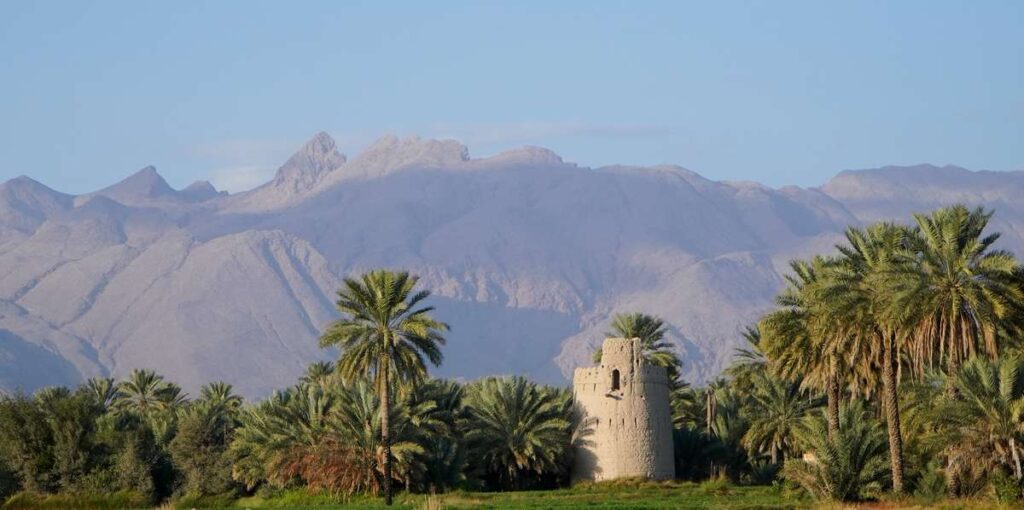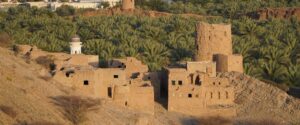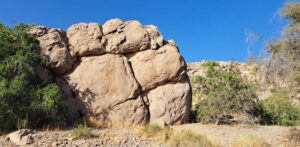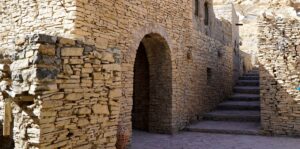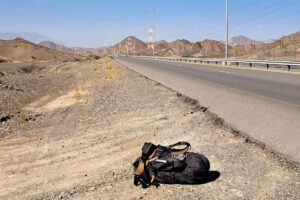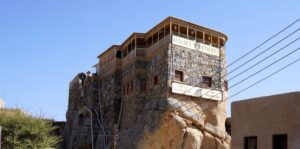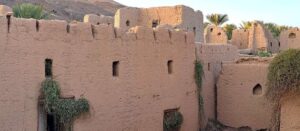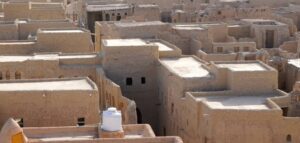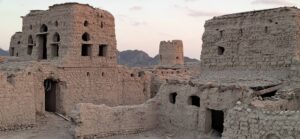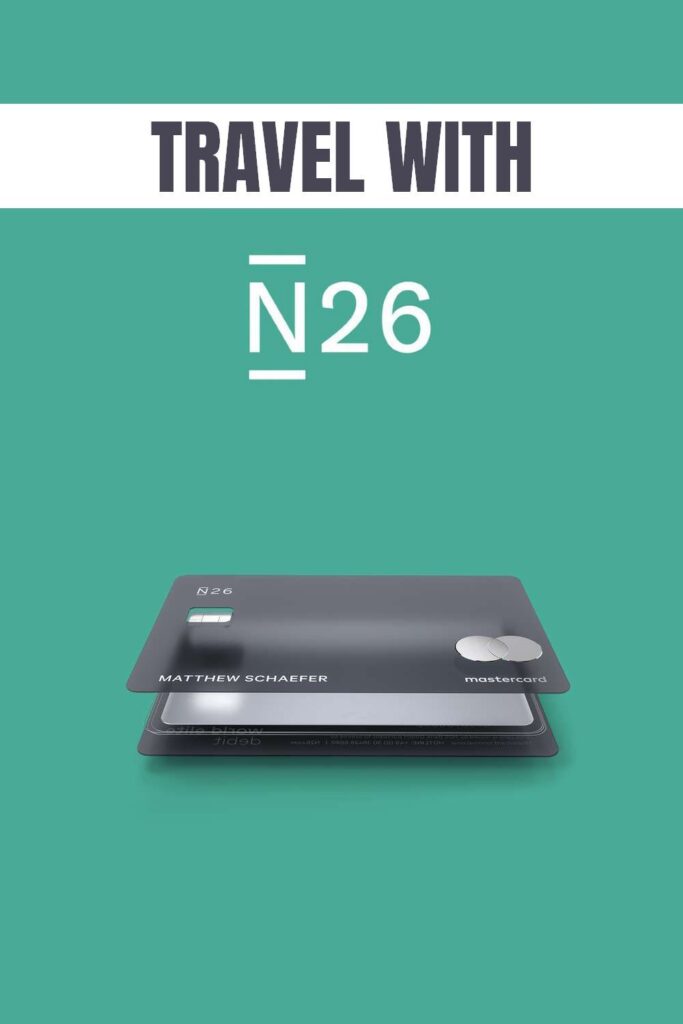▶ Destinations ▶ Oman
Visit Nizwa
Nizwa (or Nazwa) is the largest city in the Ad-Dākhilīyah Governorate region in the north of the Sultanate of Oman. It is the former capital of the country and is now one of its most important tourist destinations.
Ad-Dakhiliyah, northern Oman
The medieval town of Nizwa attracts travelers for its gigantic fort and historic villages. We will see here that Nizwa is far from being the only place of cultural interest that can be discovered. Indeed, there are many castles and ancient cities in the surrounding cities such as Bahla, Izki, Manah and many others.
Things to do and itinerary
Find in this travel guide the most popular tourist activities and things to do but also the least known. You will also find a week-long itinerary to visit the archaeological sites and cultural places of the northern region of Oman in Ad-Dakhiliyah, mainly located around Nizwa.
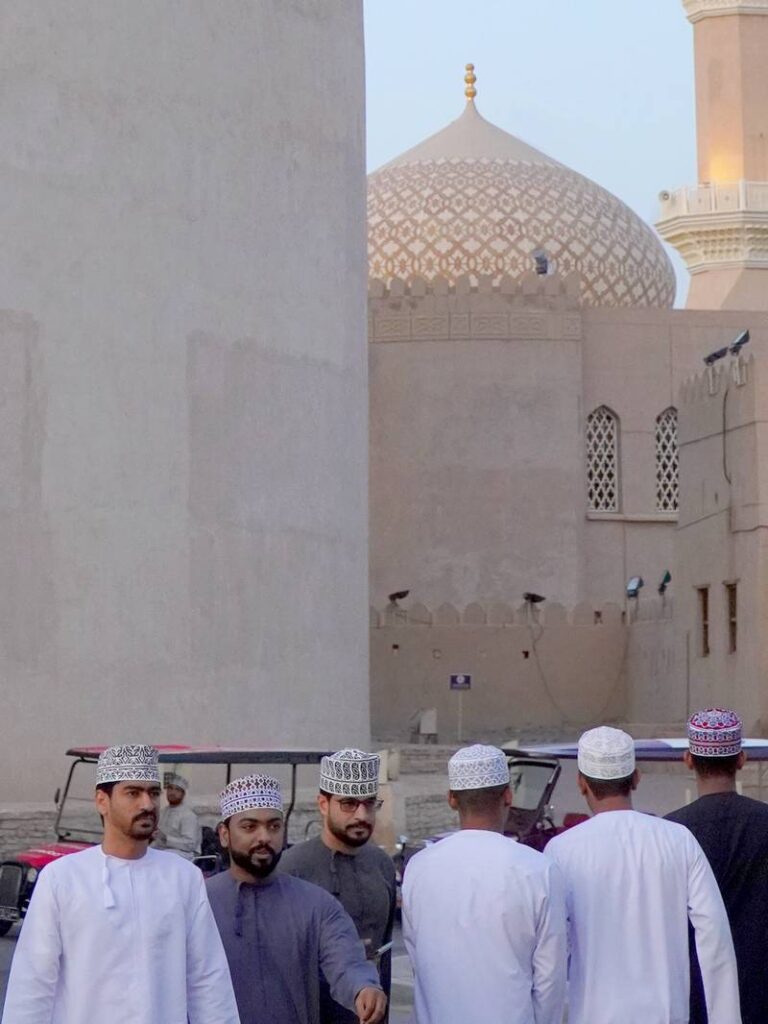
Chapka insures your trip to Oman
Get it now
Things to do in Nizwa
1. Visit the city fort
Obviously, Nizwa Fort is the must-see tourist activity of the ancient Omani capital. Built in the 12th century, it was 500 years later that it became the fort as we know it today. The complex served as the administrative headquarters at the time.
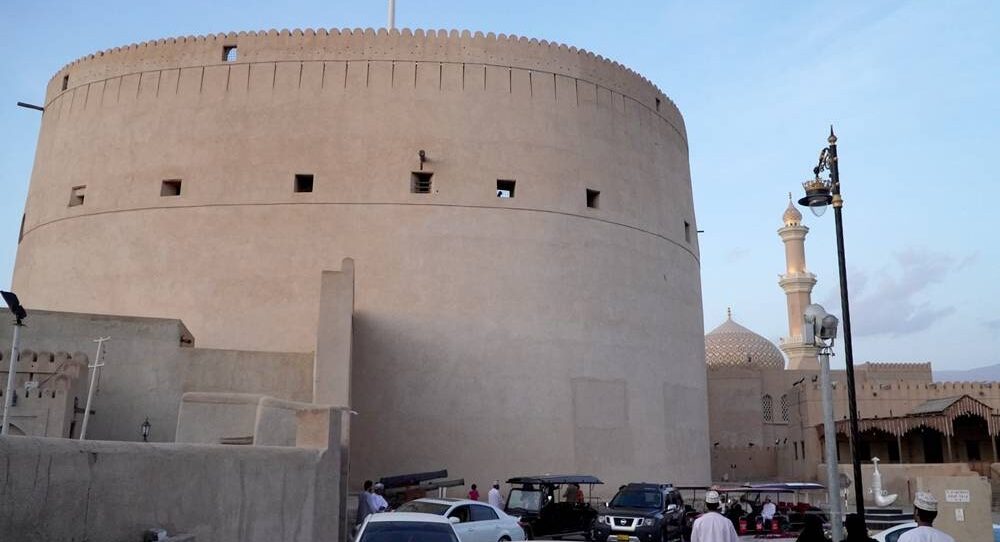
Facing the invader
Oman has experienced many invasions in the past, including by the Portuguese, the British and other Arab tribes. This explains the presence of the many fortified villages, castles or the many watchtowers in the country and consequently the impenetrable structure of Nizwa Fort.
The monument has many traps scattered but especially within its huge mother tower of 30 meters high. This fort is positioned just above an underground stream that allowed the constant supply of water.
Entrance fees
💰 The visit to the fort costs 5 OMR for foreign adults and is free for children.
2. Visit the souk of Nizwa
The large souk of Nizwa is a very popular activity throughout the region. On this day you can find everything that sells in the vicinity. It is a large market. Traders, craftsmen and farmers from the surrounding area come to sell their products. Even locals who live as far away as Izki come to visit it.
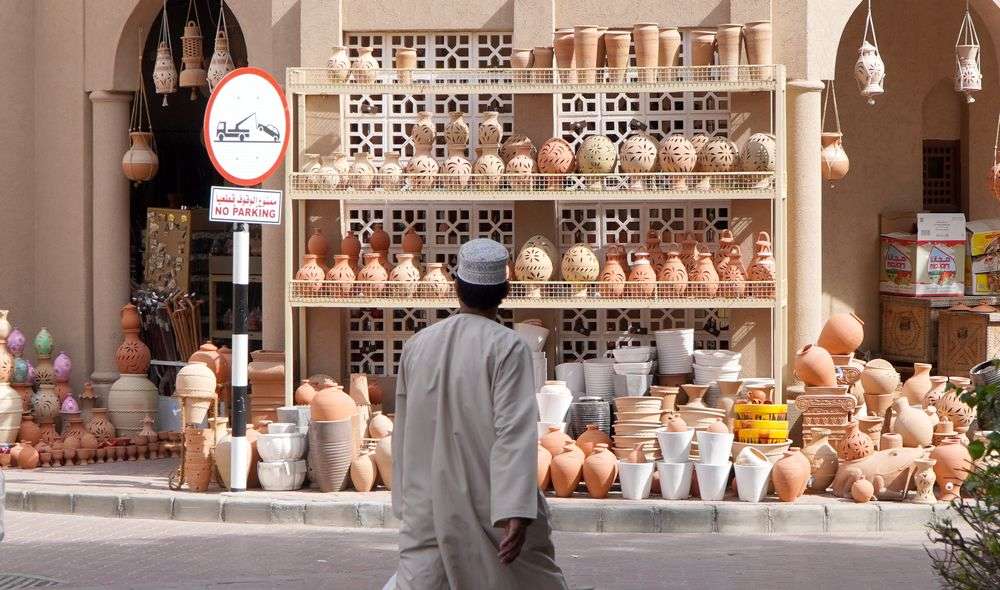
What are the timings of Nizwa souk?
It is held daily from 06:00 to 09:00 and in the late afternoon until early evening. The best day to visit is Friday morning. This is the time when the market is huge and there is the cattle fair.
3. Harat Faraq Al Qadimah
South of the city of Nizwa is an abandoned fortified village, straddling the modern city. If you visit the whole country of Oman without discovering other historical cities around Nizwa, I advise you to go and see it. If not, this is not a must-see place since you can visit better places. Keep reading, we’re getting there.
4. Lose yourself in the medieval alleys
A nice place to stroll and walk is nothing further around the fort and especially behind it. There is a maze of narrow streets where old buildings are connected to modern dwellings. Some are renovated and still in use. This place is lovely and the atmosphere is nice.
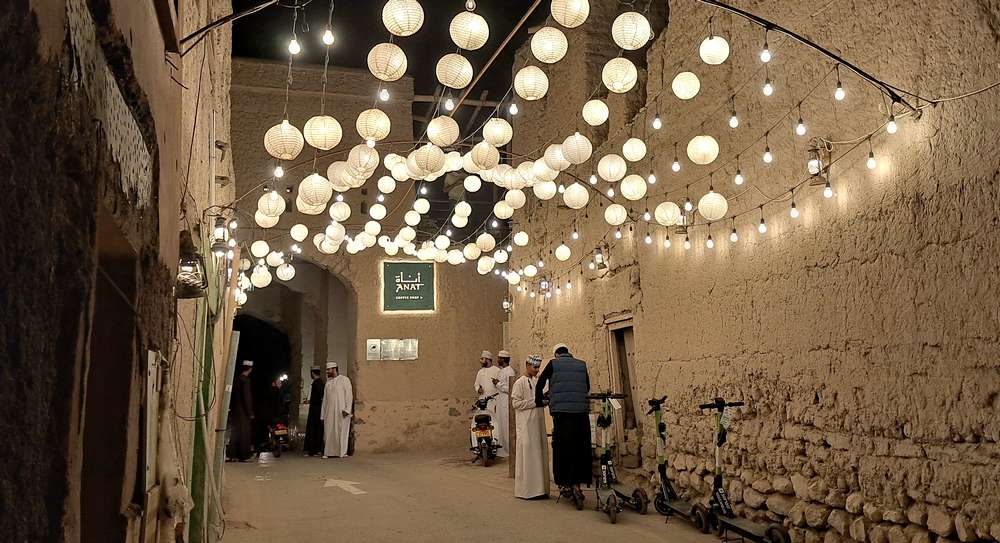
5. Falaj Daris
A falaj is a water supply system. The oldest known aflaj (plural of falaj) date back up to 5,000 years and are located in Iran. Those of Oman date from about 500 AD. We find this system similar to the Morocco, especially around the Atlas.
UNESCO Site
Falaj Daris, as well as 4 other aflaj in Oman are classified by UNESCO.
6. Ruins of Tanuf
Tanuf is a locality located 19 km north of Nizwa at the foot of the Al Hajar Mountains. To the south of the modern commune and on the edge of the wadi are the remains of a village now abandoned. Its state of conservation is critical as it suffered a war in the 1950s and it has never been restored. The site remains a very beautiful place to visit.
7. View of Nizwa from the mountains
You can climb the mountain that lies east of the city center. From this point, you have the opportunity to see Nizwa in its entirety with stunning views of the fort.
8. Sultan Qaboos Mosque
The Great Mosque of Nizwa is located at the entrance of the city. Its interior and exterior architecture is remarkable. You can visit it anytime except Friday from 11:30 to 13:30 if you are not Muslim. Nizwa is the spiritual and religious capital of Oman and this mosque is the most important in the country after Muscat.
Habits & customs: reminder
The Sultanate of Oman is a Muslim and very conservative country. As you can see, 99% of Omani adult adults have their bodies completely covered in a traditional dress called dishdasha. The same goes for women, who all wear an abaya.
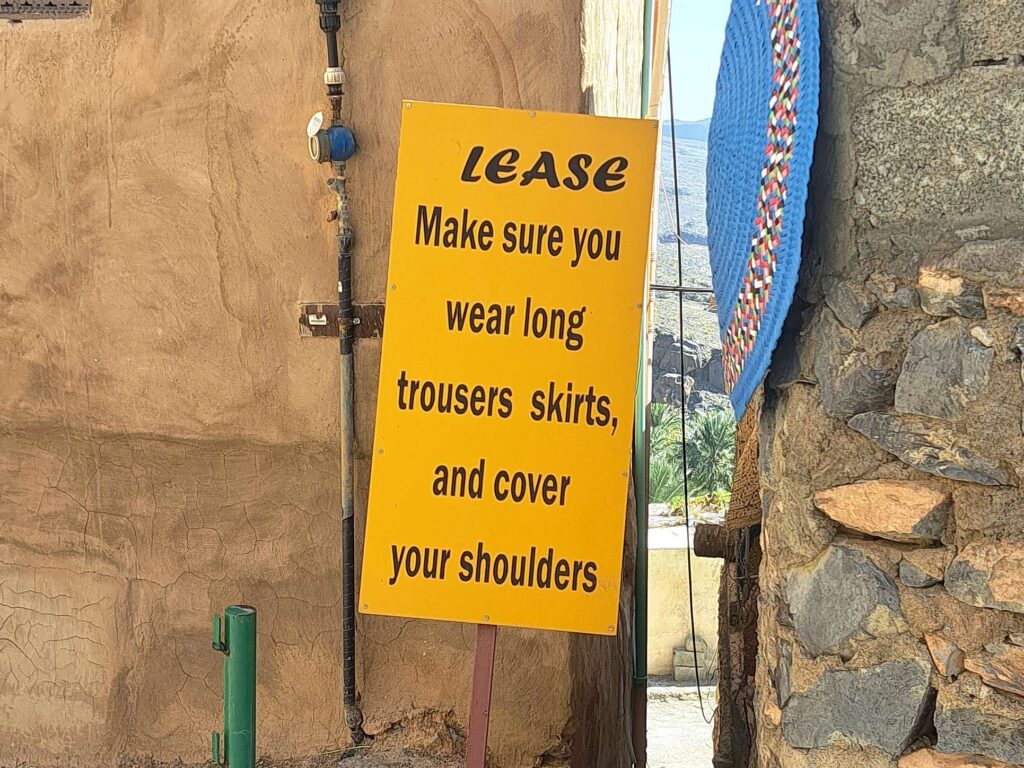
Please make sure to wear pants and cover your shoulders”
Dress code
Dressing in Western style is not a problem in itself. But the minimum required is to cover your shoulders (i.e. no tank top) and cover your legs, for both men and women and especially out of the big cities.
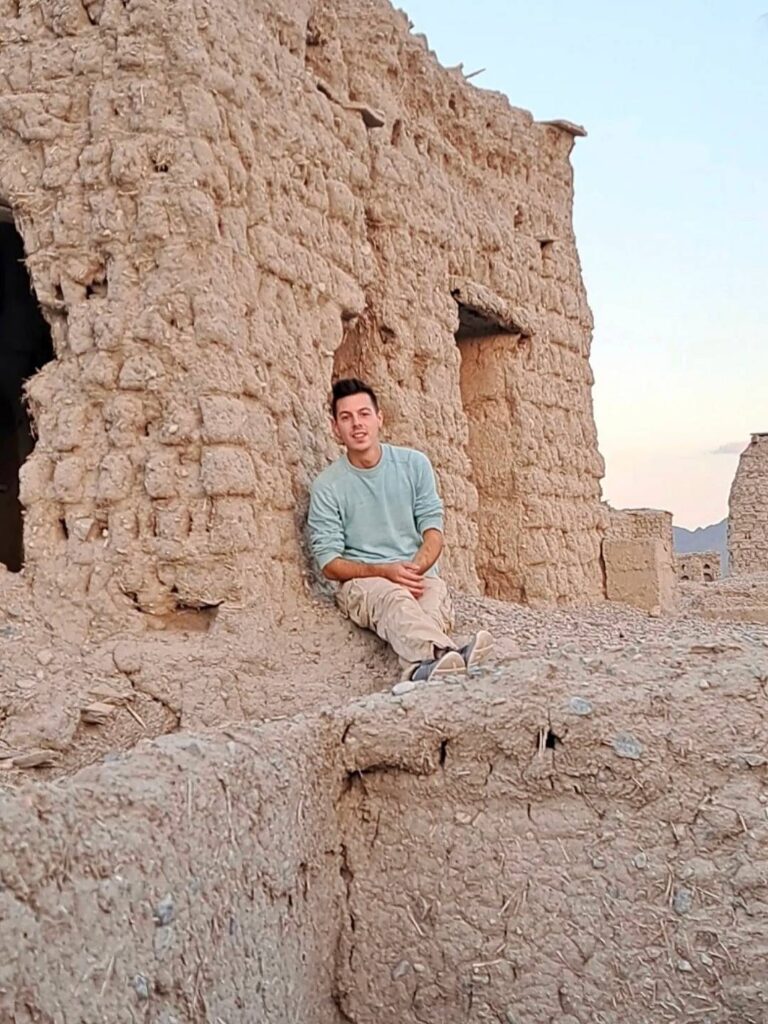
Visit Izki
Izki is the oldest city-city of the Sultanate of Oman, precisely Harat Al Yemen, which is mentioned in the inscriptions of the plates of Ishtar in Mesopotamia in the current Iraq, as far back as 640 BC.
1. Harat Al Yemen
Harat Al Yemen was the most important city of Izki, it was once impenetrable. The remains are in a critical state of deterioration. The strong point is that everything is original and nothing is distorted. I don’t know why, but very few tourists visit it. I have never seen anyone here. The entrance is free.
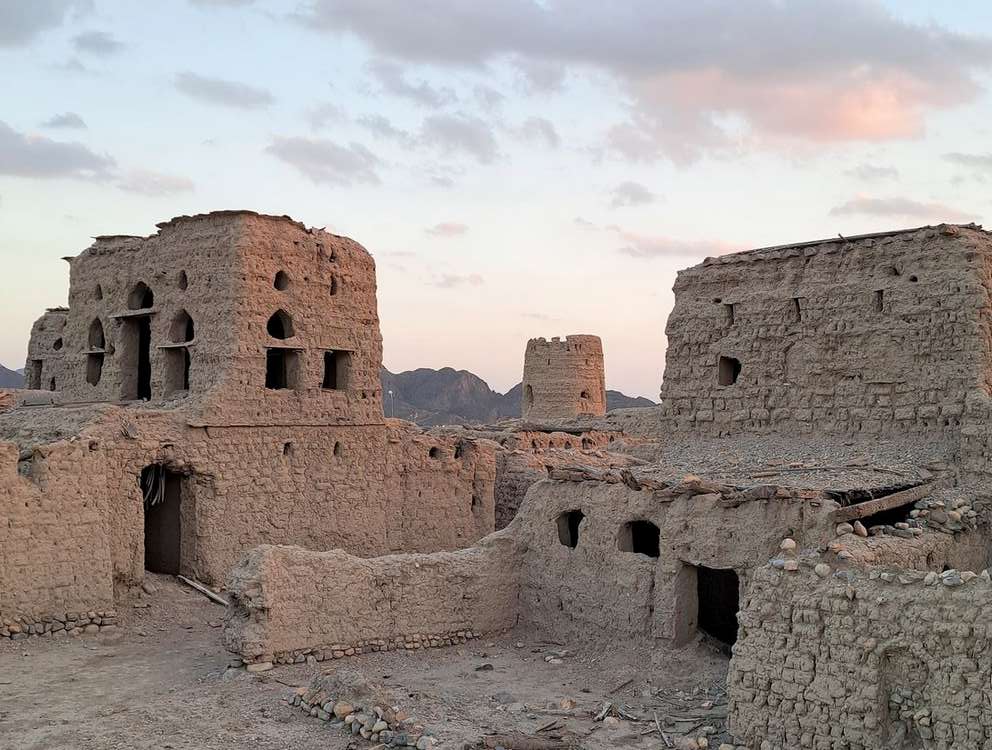
2. Husn Izki
Directly opposite the city are the ruins of the ancient castle of Izki, the administrative seat of the city. Its visit is free.
3. Second village
A little further north of Harat Al Yemen is another abandoned village. It is connected to the modern city and has no ramparts. The site is better preserved than the previous ones.
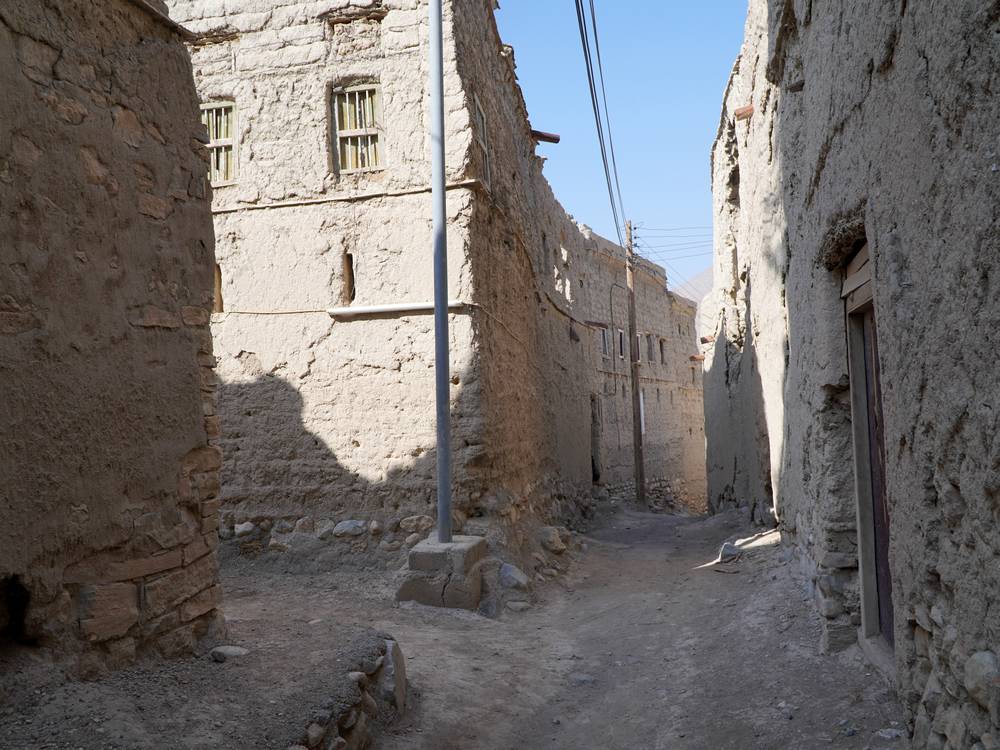
4. Jarnan Cave
Just below this same village are caves, or rather cavities. One of them is still preserved, Jarnan Cave. Legend has it that at the beginning of the birth of Islam, a golden calf appeared at the bottom of a secret passage at the end of the cave. This one would be protected by jinn.
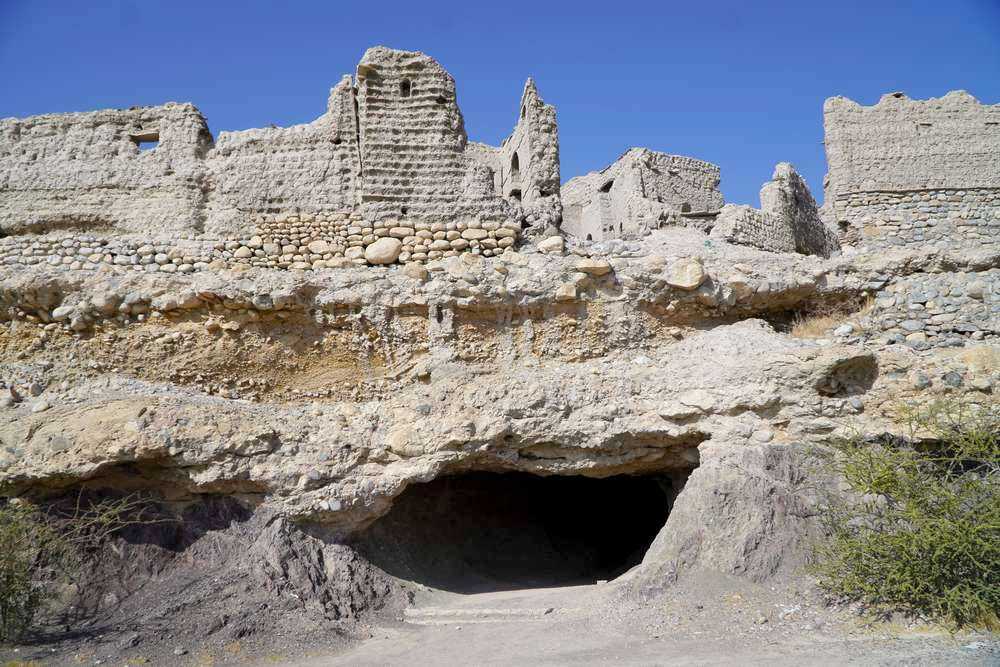
Jinn in Oman
Jinn exist in several cultures and especially in Muslim culture. In Oman, this belief is very strong. They would live in abandoned or uninhabited places such as deserts, mountains and especially in ruins. Suffice to say that according to this point of view, they would be everywhere in the country.
How to access it?
Enter the village and head towards the wadi. From here you will find a terrace below. The cave is just below. Otherwise, when you leave Harat al-Yemen, head into the wadi. When you see the first ancient dwellings, the cave will be just below.
Visit Manah
1. Harat al Bilaad
Harat al Bilaad is a must-see place and very close to Nizwa. This ancient village of about 250 houses is fortified and protected by a thick wall. It is very interesting to visit since a large part is completely restored. Here, we have a real glimpse of what this kind of Omani dwellings of the past could have looked like. A large watchtower overlooks the entire site and 4 mosques are still in use inside.
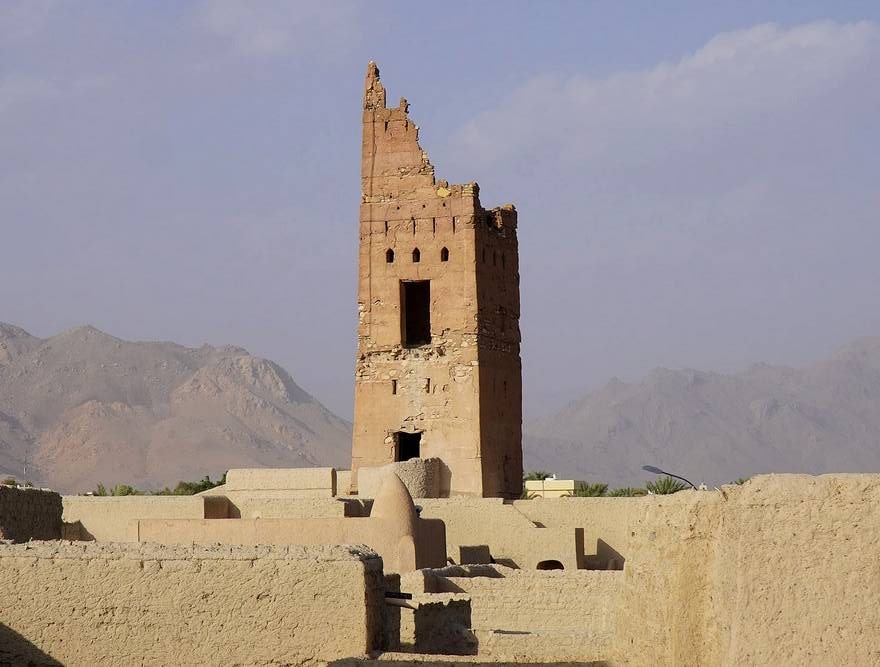
The restored part is so well maintained that every room of every house is like new. It is a historical site absolutely to register on your travel itinerary in Oman.
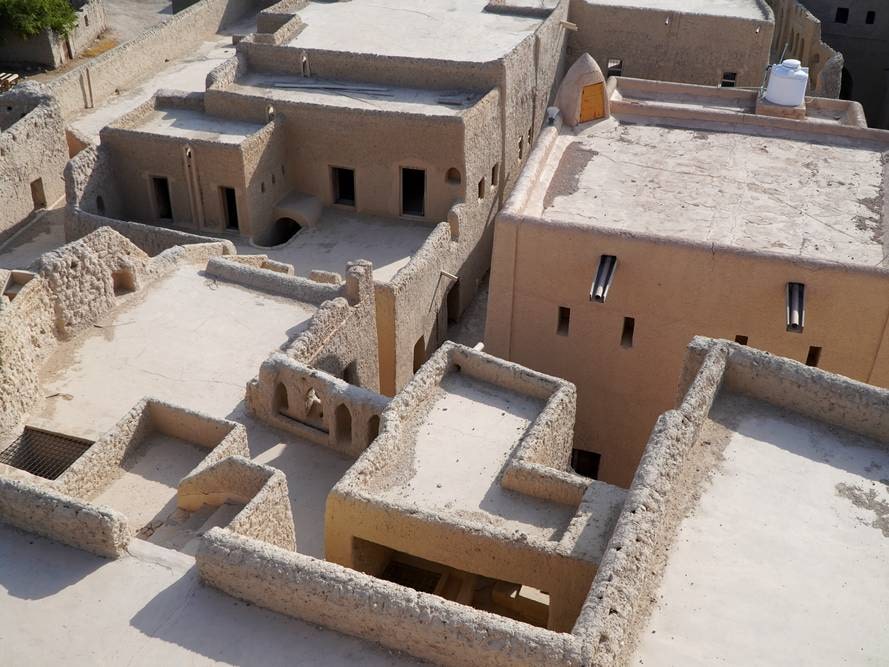
Entrance fees
💰 The tour costs 2 OMR.
2. Al Fiqayn Fort
Al Fiqayn Castle is an interesting activity to do around Nizwa. The monument is huge. It served as a defense and observation tower in Manah but also as a prison. On the 4th floor was a well-protected library where religious and scientific books, important manuscripts and administrative documents were kept.
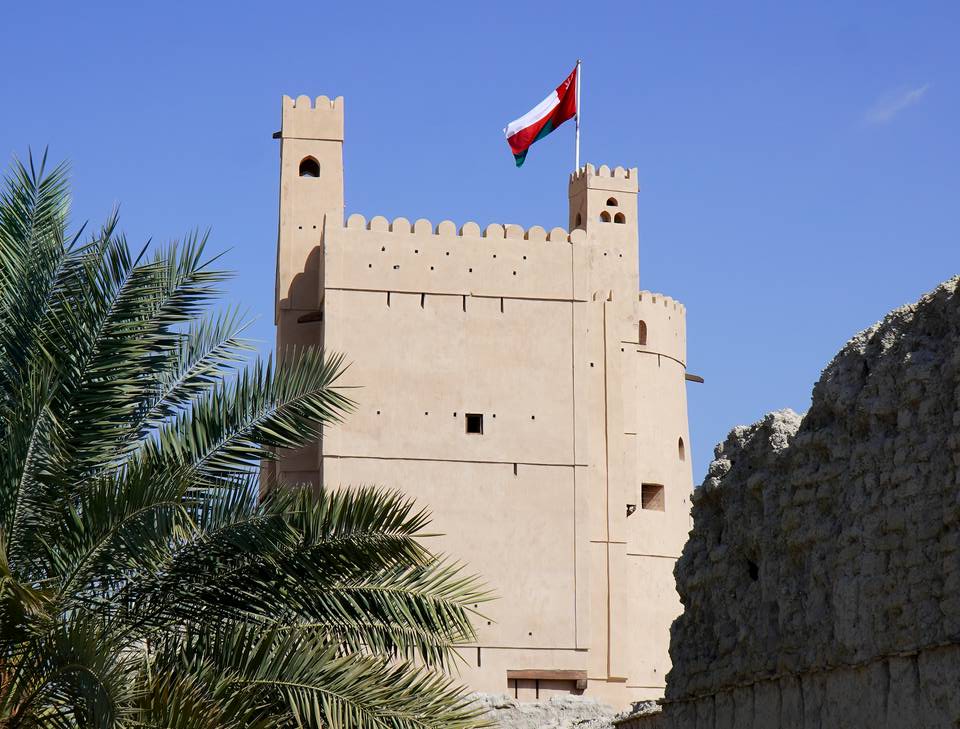
You will see many small holes strategically scattered. They were used to pour boiling oil on the invaders. This was a common defensive technique in other forts in the country.
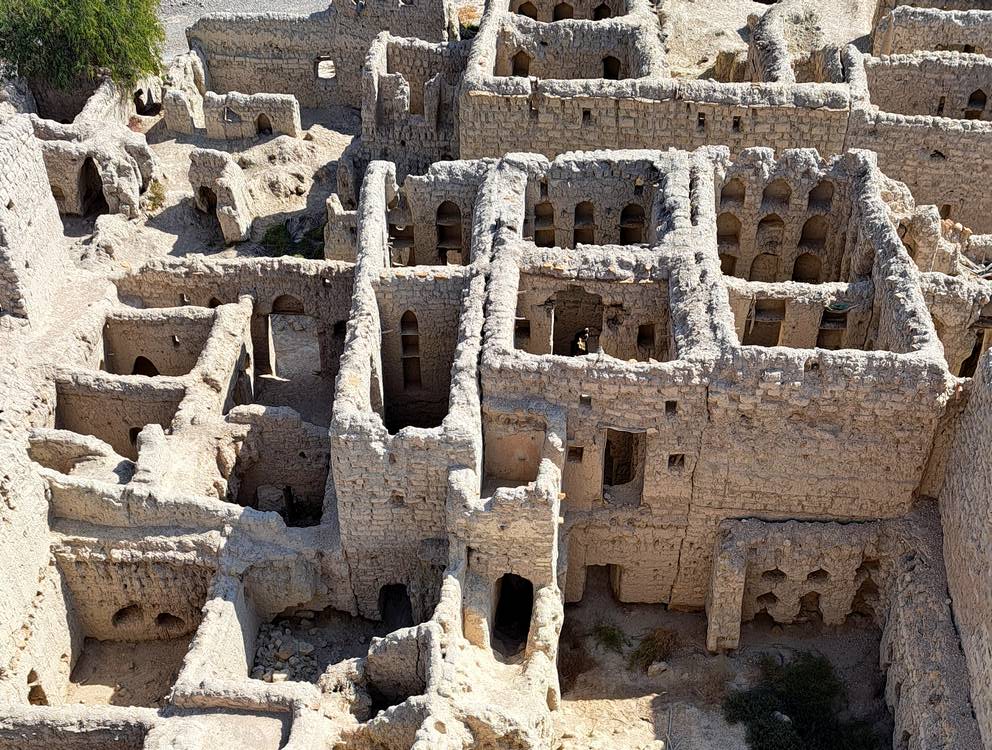
Entrance fees
💰 The tour costs 500 baisa (only per card).
Visit Zukait
Zukait Tombs
The small village of Zukait located in the wilayat of Izki is worth a visit for its archaeological site. On the heights of the town are many graves. They are nicknamed “the hives” for their shape and because they are hollow. They consist of flat stones available on the mountains.
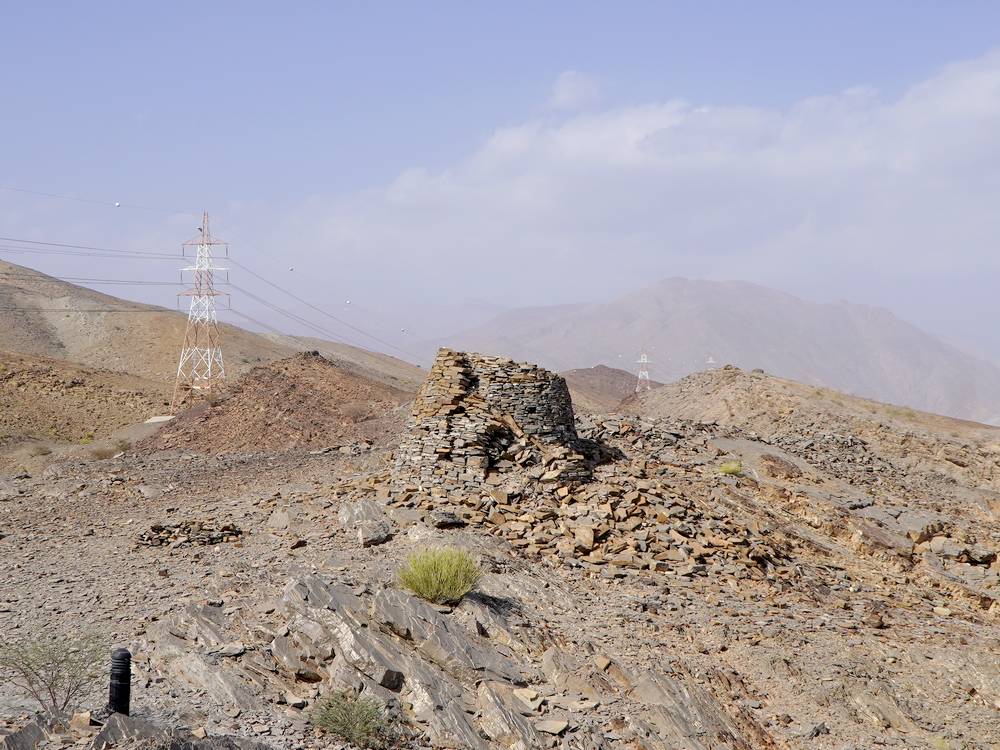
The age of the funerary complex dates from the Bronze Age. It is a very important site in the historical heritage of the Sultanate of Oman as it testifies to human activity as far back as 3,000 BC. These tombs involved the extraction of rocks, their cutting and all the masonry work. They are numerous and scattered all around the valleys on the rocky peaks.
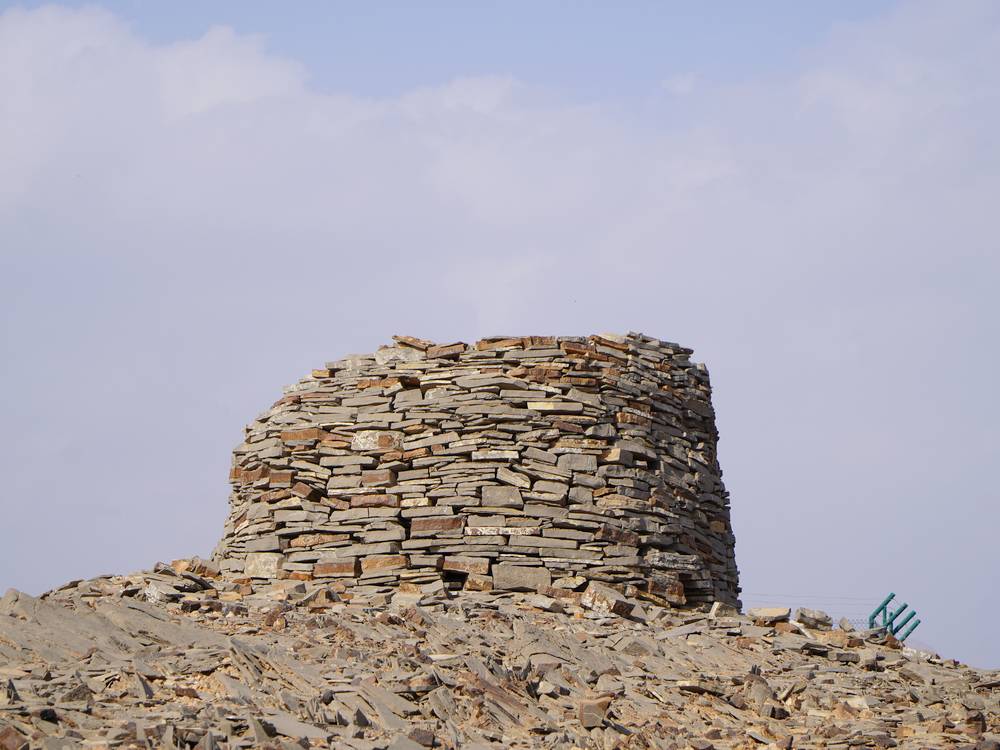
Visit the Zukait Tombs
This site once very popular with tourists is now completely neglected. A café was constantly open downstairs from the funeral complex for visitors. Today, it is abandoned. Just like me, you will most certainly have all the space of the historic site to yourself.
Visit Birkat Al Mouz
1. Falaj Al Khatmain
Al Khatmain is one of the 5 Omani aflaj (falaj singular) listed as a UNESCO World Heritage Site. That of Birkat Al Mouz is more than 2,000 years old and has its source in the mountains of Akhdar. Having followed him all along, his career is impressive.
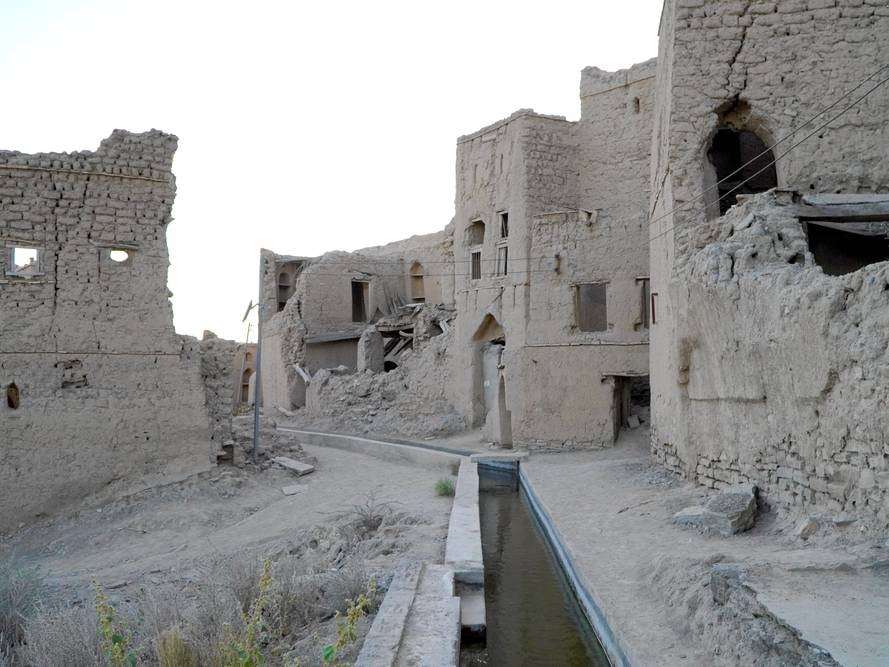
It arrives straight at Fort Bayt Ar Ridaydah, crosses the city and then the ancient village Harat As Sibani and Burj Al Maqaseer for domestic use. Finally, the water is conducted on another falaj of aqueduct type several meters high to serve the palm grove and irrigate the plantations.
2. Harat As Sibani
The abandoned village (harat) of Birkat Al Mouz is striking and sublime. It was built straddling the plain and the mountain. This village was still inhabited at the beginning of the 21st century. (Previous photo)
Like most other harat of the time, the houses were built of adobe, except for a part. Indeed, the upper parts of the village were made only with dry stones available directly on the site. The combination of these two types of construction is interesting to visit.
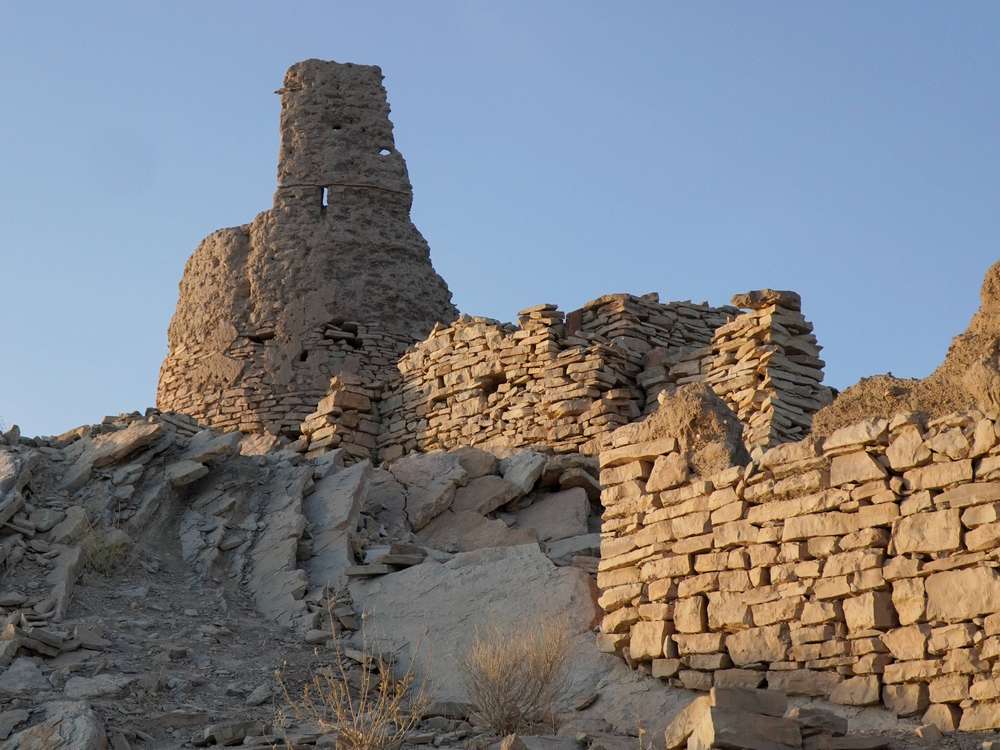
2. Harat Al Maqaseer
Harat Al Maqaseer is an abandoned village located 300m from Harat As Sibani.
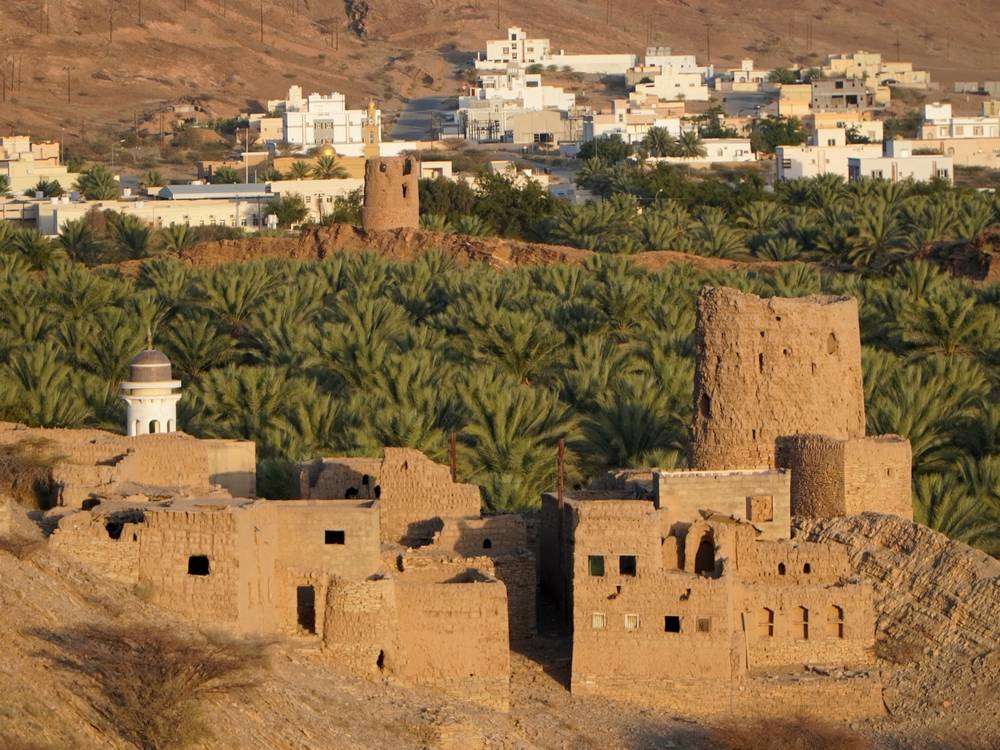
3. Burj Ghiyadha
Burj Ghidaya is a watchtower in Birkat Al Mouz. It overlooks the whole city and even the castle, with the exception of the harat. You can’t go inside but the view of the hill over the city is interesting.
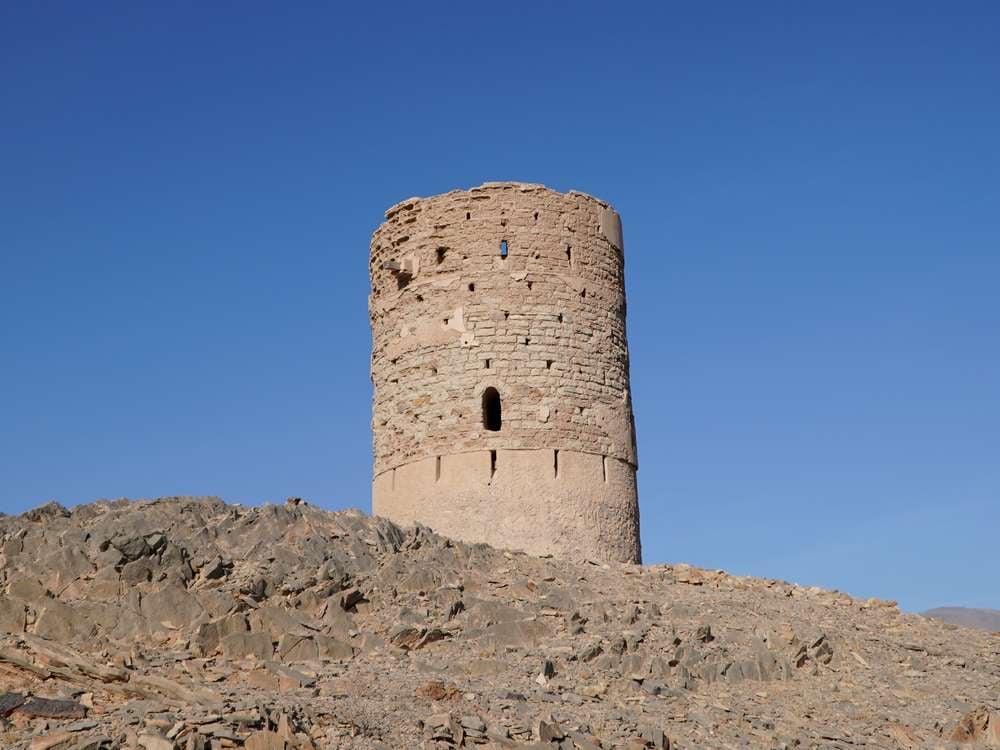
4. Bayt Ar Ridaydah
Birkat Al Mouz Castle was founded by Imam Sultan Bin Saif in the 17th century. Restored in 1998, it was later converted into a museum of traditional Omani weapons. You will be able to see the progression of attack and defense techniques over time.
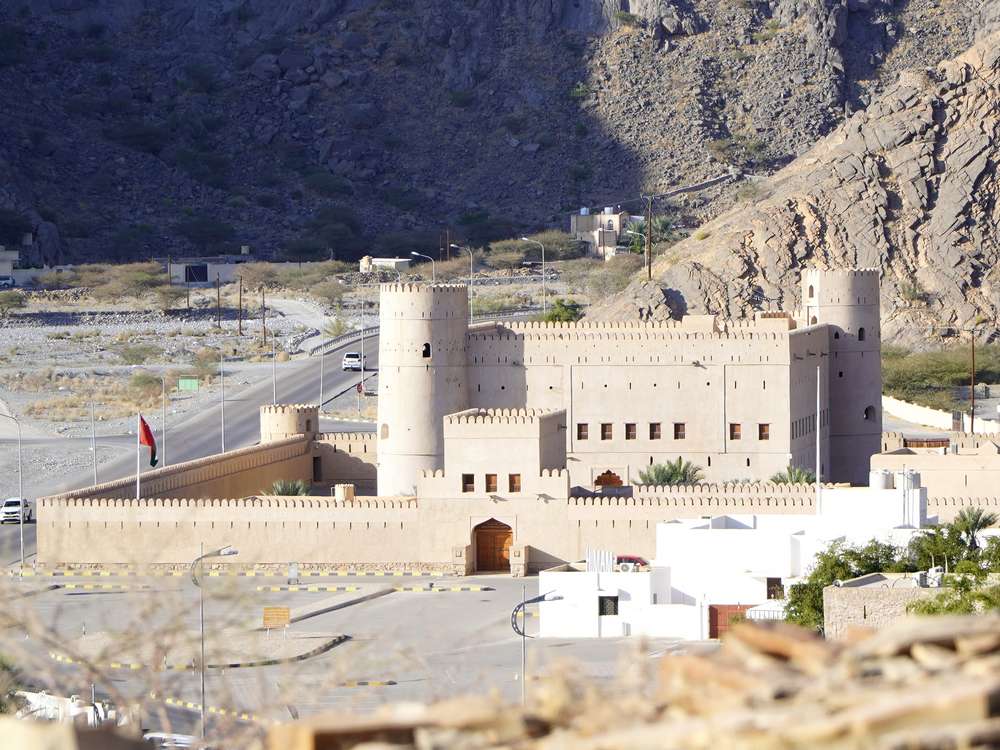
Entrance fees
💰 The visit of the fort costs 7 OMR.
📸 See more Birkat Al Mouz photos
Visit Bahla
A few kilometers from Nizwa, Bahla is a city often added on the itinerary of travelers to the Sultanate of Oman.
1. Fort de Bahla
Bahla Fort is a remarkable mud monument. The fort was built by the powerful Banu Nebhan tribe that dominated the area at the time and was known to control the incense trade. We do not know its actual date of construction but estimates indicate a period between the 12th and 15th century. This fort is classified by UNESCO.
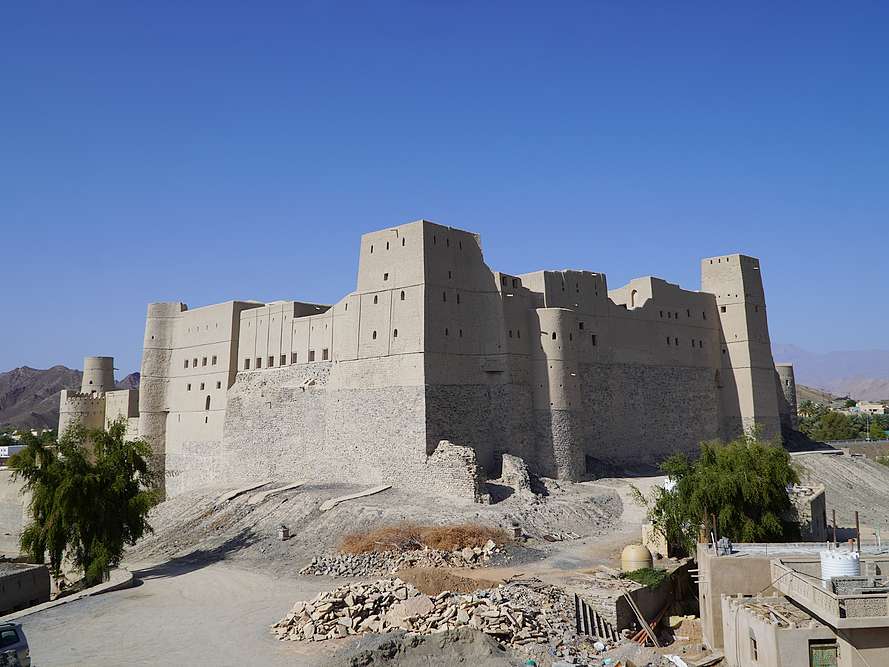
Entrance fees
💰 The visit of the fort costs 7 OMR.
2. Castle of Jabrin
Jabreen is a different town from Bahla (on the outskirts) but it is located in the same locality. A detour here can be interesting as there is a castle to visit there. It was built in 1675 by Imam Bil-Arab Bin Sultan and is today in an excellent state of preservation.
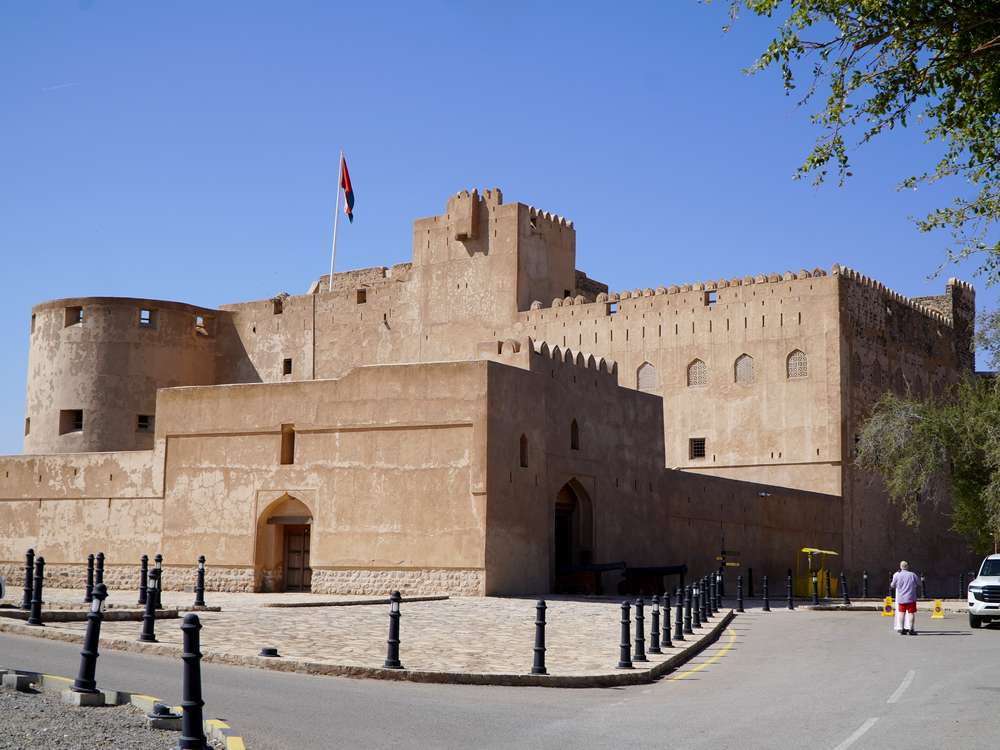
Entrance fees
💰 The visit to the castle costs 500 baisa.
3. Bahla Souk
Bahla Market is an activity to do during your visit around Nizwa. Here you will find all kinds of crafts. Especially traditional, such as ancient daggers, swords or jewelry. Head to the market early in the morning to watch the cattle trade. Or mainly goats, sheep, cows and more rarely camels are sold. The souk reopens around 17:00.
4. Historic Mosque
It is believed that this ancient mosque was built in the century following the birth of Islam. This very important religious monument would therefore be about 13 centuries old. A must visit if you are around. Unfortunately, it was closed when I was there. The mosque includes an underground part.
Entrance fees
💰 The visit of the mosque costs 1 OMR, only by credit card.
5. Viewpoint on Bahla
Overlooking the town of Bahla from the best vantage point. From this place you can take the most beautiful photos of the fort with the mountains in the background.
Visit Misfat Al Abriyyin
1. Visit the village
Misfat Al Abriyeen is a small mountain village located at the beginning of the Akhdar and no older than 5 centuries, at 700 meters above sea level. It is a town with an interesting architecture since the houses are built on the rock walls by marrying the shapes of the rock. There are even some semi-troglodyte constructions.
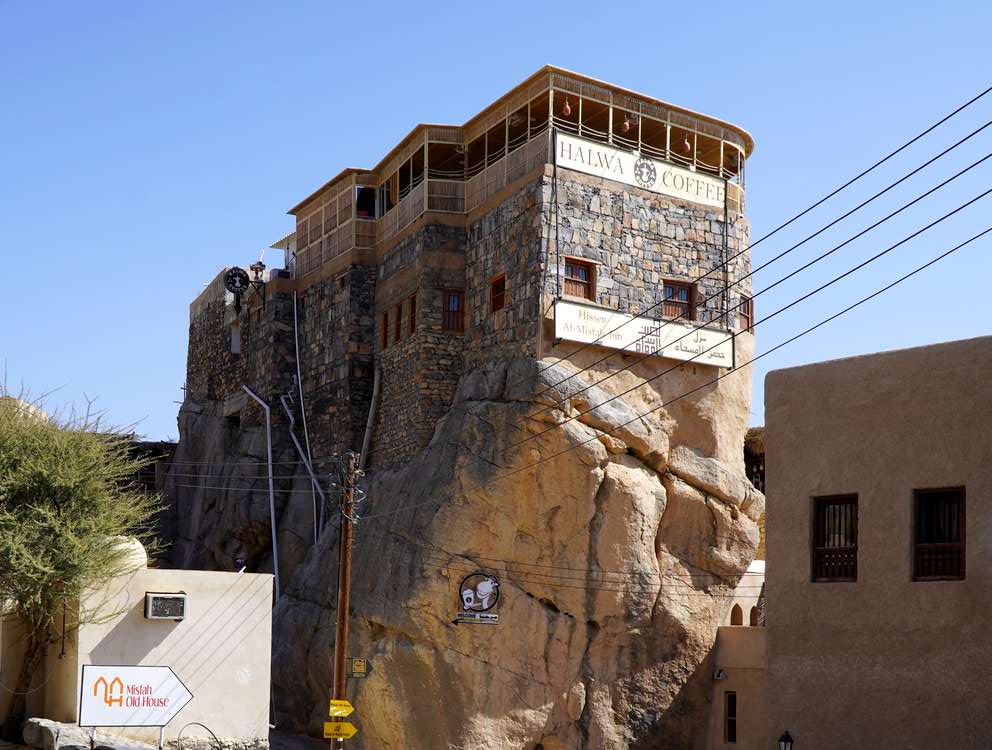
2. Village similar to Misfat
The place is very interesting to visit for its atypical layout. Obviously, it is a place that attracts many tourists for the visual aspect but the truth is that such beautiful villages, there are many others. The difference is that it has been set up to receive tourists and that cafes and hotels distort it somewhat.
If you are looking for pure authenticity, I advise you to look on the map and you will find many others (without amenities to eat or sleep and in a different style on the contrary).
Take a look at this one for example,
a few dozen kilometers from Misfat Al Abriyyin:
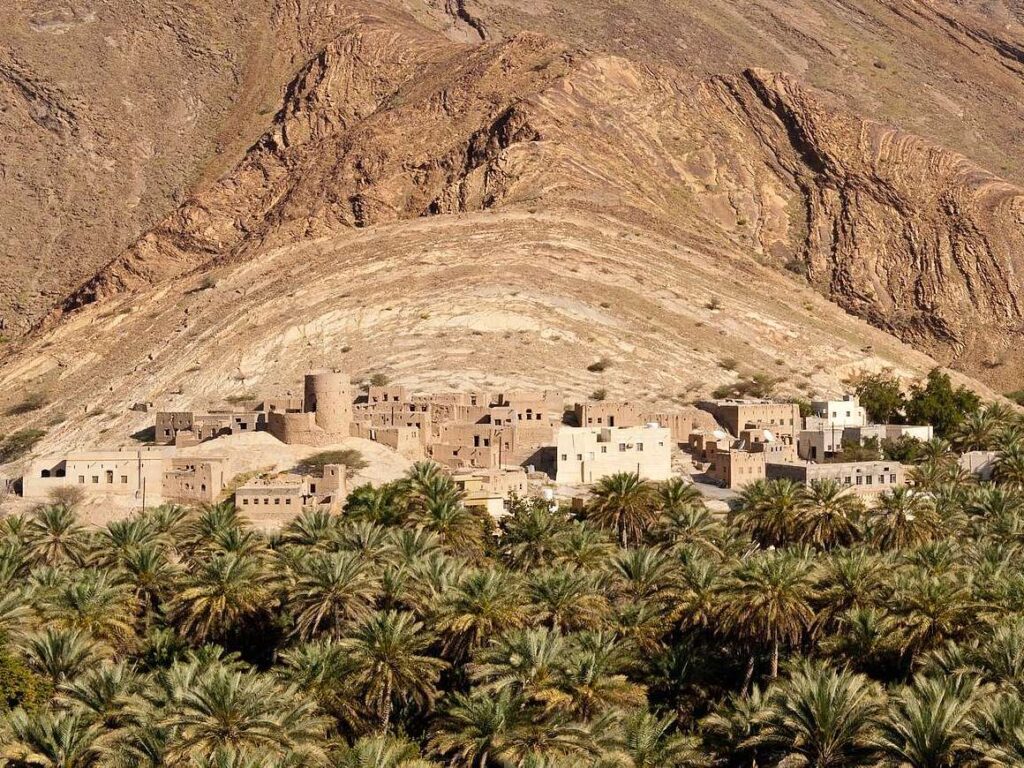
3. Rogan Watchtower
The sources of the origin of this “fort” which looks more like a watchtower contradict each other. Anyway, its construction and location of a block on the rock is just amazing and worth visiting. Unfortunately, a piece of the spiral staircase is destroyed. The passage requires at least one safety rope. I tried it without it and it is very dangerous.
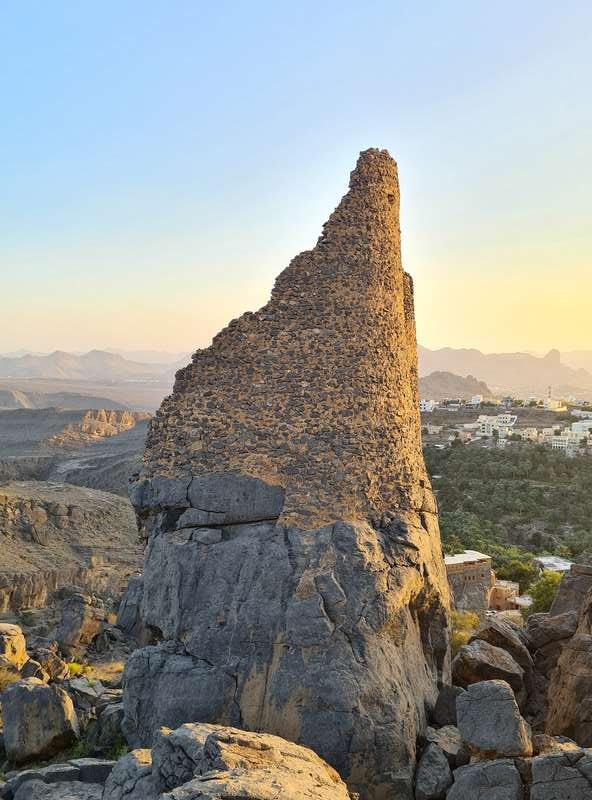
4. Hiking
Go down to the foot of Misfat in the palm grove and then follow the falaj towards the West. It will take you to a valley that you can follow for several kilometers and then offer you the most beautiful views going up.
5. Appropriate dress
The dress code is strict at Misfat Al Abriyyeen. Before you even find the welcome sign in the city, you will find another one where it says to have an appropriate outfit (shoulders covered, no shorts). When I came, very few tourists unfortunately respected it.
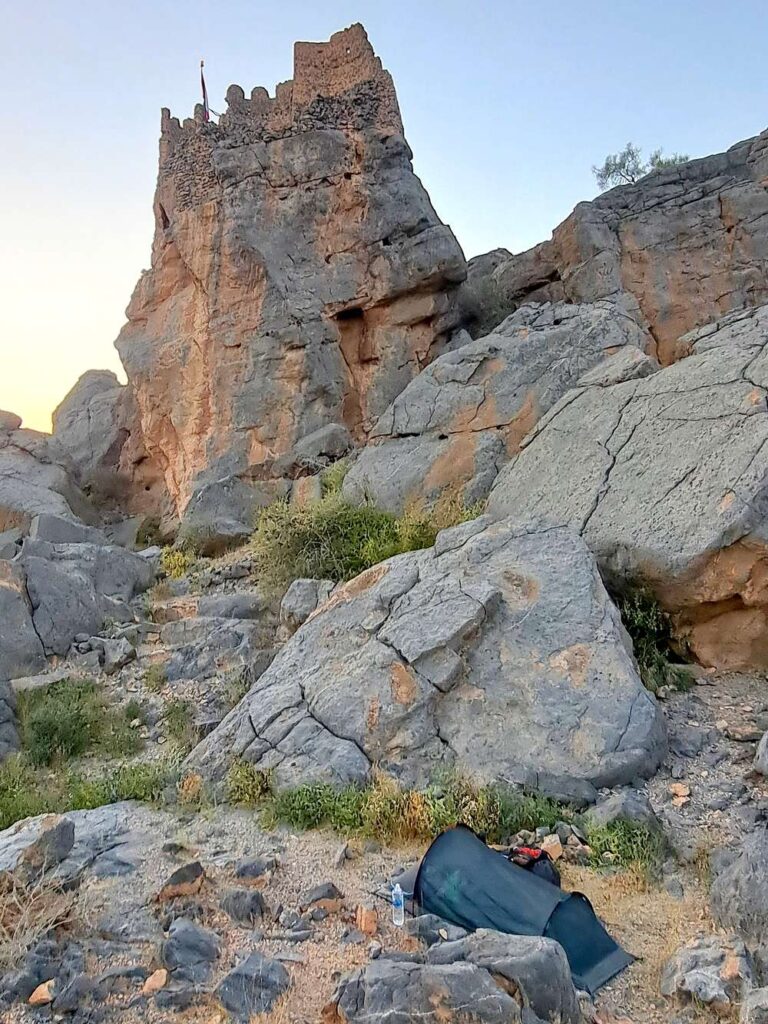
Visit Al Hamra
Al Hamra is the city that precedes Misfat Al Abriyyin. You must go there if you want to access the small mountain village. If you have time to visit other things, that’s good because there are 4 activities to do.
1. Rock carvings of Bin Salt
A few steps from Al Hamra, in the wadi, are 2 archaeological sites. the first is called Bin Salt (also called Hasat Bani Salt Rock or Coleman’s Rock). The first name refers to the Sultan of the time who would have been saved from an enemy attack by climbing on the rock (according to the locals). The second comes from the American who made known to the world the existence of the rock engravings that are inscribed there.
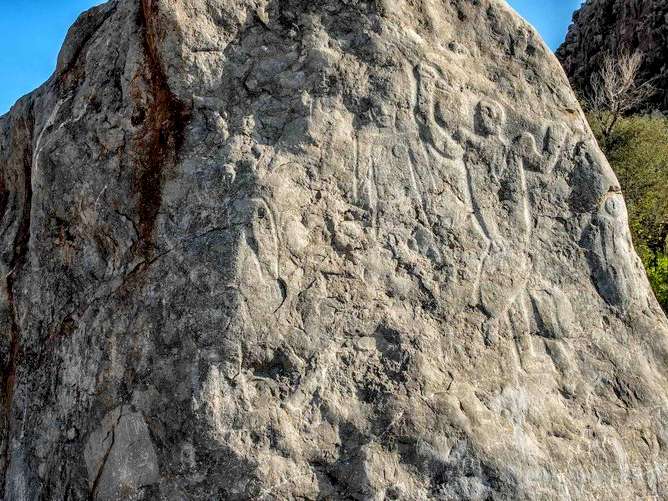
Petroglyphs
These petroglyphs depict women with muscular men. These engravings date back about 5,000 years. Unfortunately and go find out why, this rock has been suffering from degradation for years (while the place is full of other rocks) and has more recently been vandalized. During my visit, I could only make out a few heads with the naked eye and the grooves that make up the bodies only by passing my hand over them.
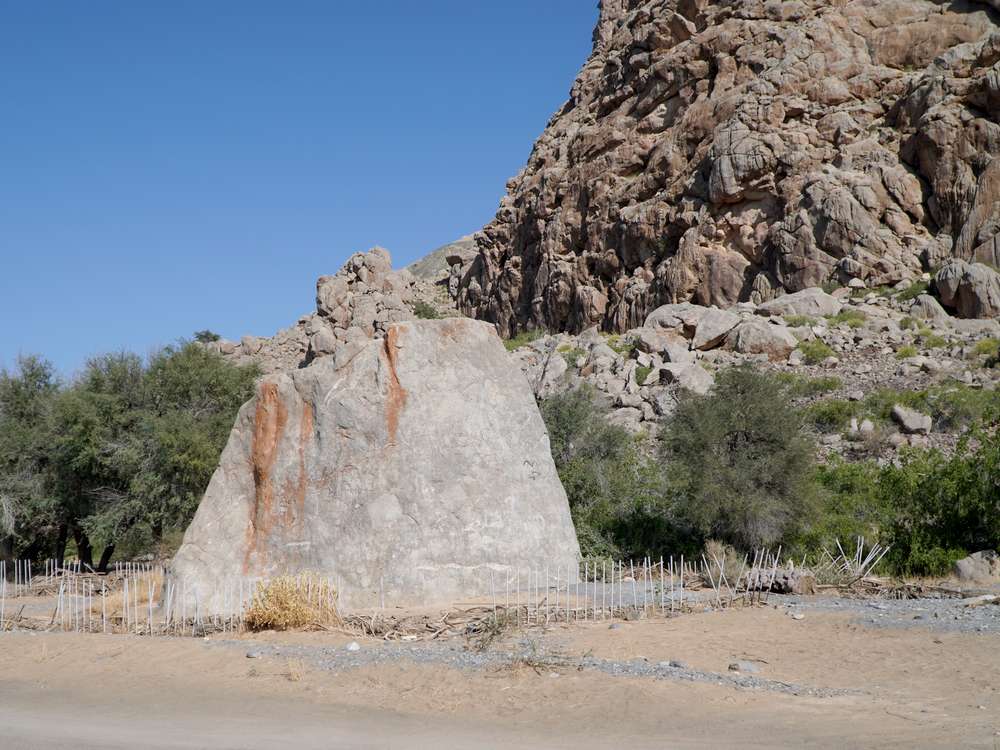
Tips for visiting
As you can see in my photo, we can hardly distinguish anything. In order to better distinguish the engravings, I advise you to come in the late afternoon or mid-morning. The sun’s rays will bring out the shapes thanks to the shadows. I was there at the wrong time, in the middle of the afternoon.
2. Second site
A few steps from the site preceding on the other side of the wadi, are other many petroglyphs scattered. Thank God they are spared. You will also find anthropomorphic engravings, riders on camels and what is thought to be a bovine (this one is big). The most recent are about 2,500 years old. Indeed, these sites have been used over a long period of time.
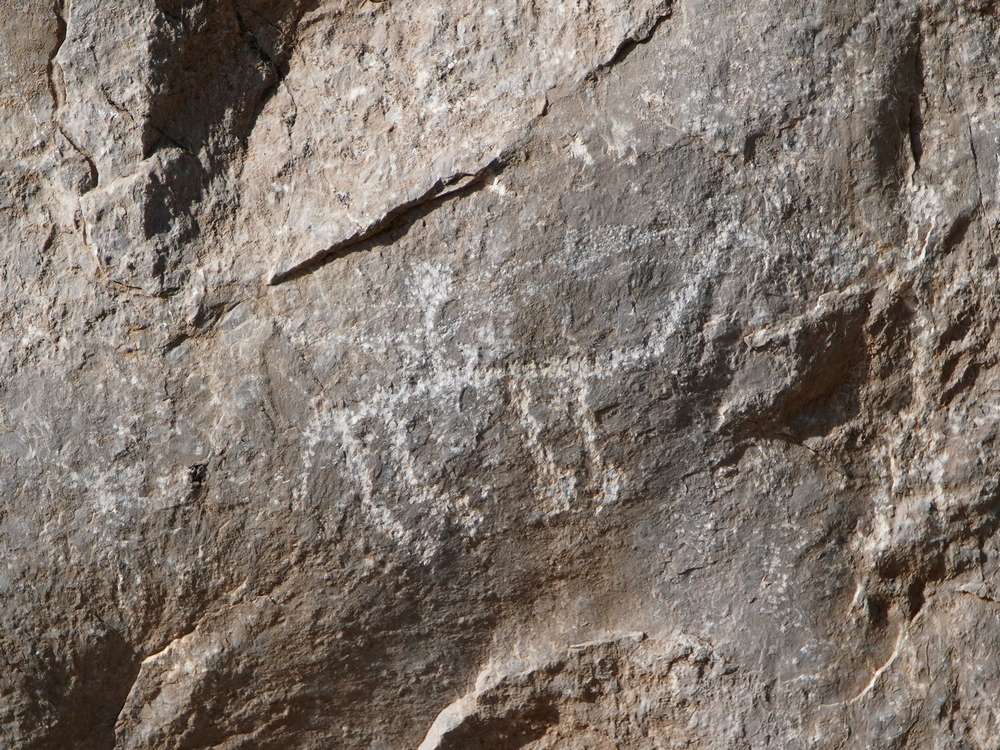
3. Third site
In fact, on the road from Bahla to Al Hamra, there are several scattered sites. If you don’t have time to do the 2 previous sites a little more isolated, you can easily stop by the side of the road to observe another one. This one represents riders on horseback.
4. Harat Al Safah
Harat Al Safah is the ancient village of the city of Al Hamra, a few dozen kilometers from Nizwa. On the way to Misfat Al Abriyyeen, this is an interesting place to stop for a visit. Some houses are restored and others still inhabited. You can also visit a craft museum and see ancient activities carried out by the locals. His name is Bait Al Safah.
Visit Bat, Al Khutm and Al Ayn
The necropolises of Bat, Al Khutm and Al Ayn are the best-preserved set of Bronze Age burial complexes in the world. These sites are therefore more than 5,000 years old. I did not have time to visit them, yet it is a must if you make a cultural trip to Oman.
The sites include more than 150 burials. The complex is not part of the governorate Ad Dakhiliyah but Ad Dhahira. Being close to Nizwa, it is worth visiting if you have time.
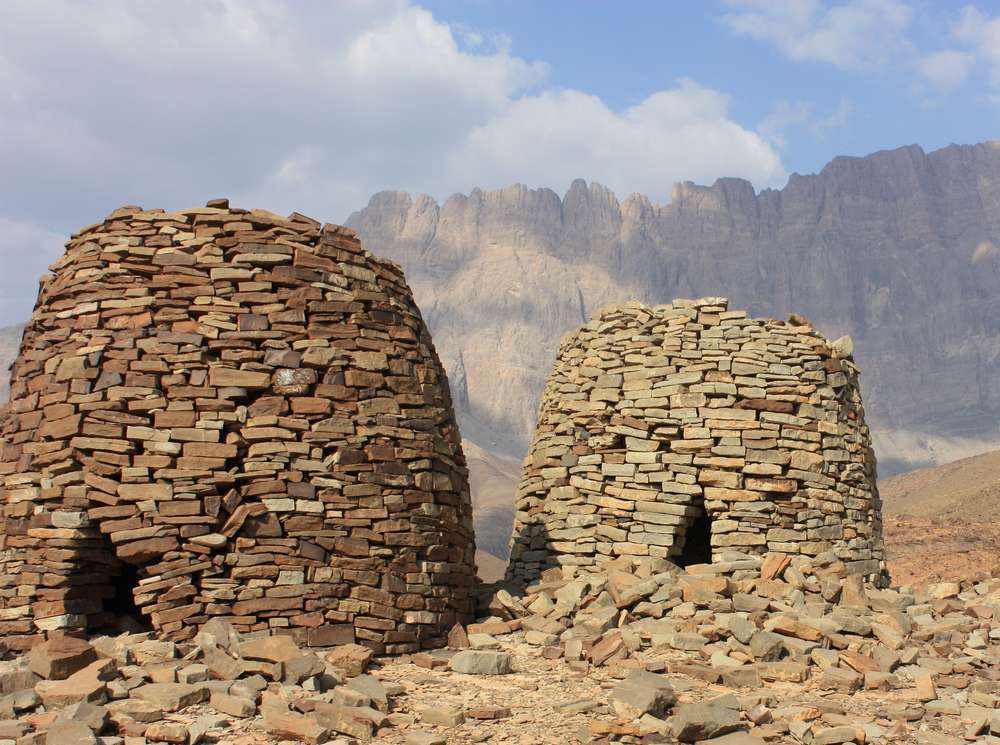
The tombs are similar to those of Zukait. However, these sites are extremely comprehensive and many of the cookies found there will give you the opportunity to understand exactly how people lived here. Whether at the level of agriculture, rock cutting, extraction in quarries (…). If you are interested in this site, I strongly advise you to refer to this article written by UNESCO:
🔎 Learn more on the UNESCO website
Visit Al Ghafat
My visit to Al Ghafat is the result of my research using Google Maps. I realized there was a historic place to visit that I hadn’t heard of, so I went. A nice surprise since the abandoned village is completely surrounded by a huge palm grove and the place is of absolute peacefulness, being set back from the cities. Its charm and the atmosphere it gives off is very different from the others. I just took the picture that illustrates the article in Al Ghafat.
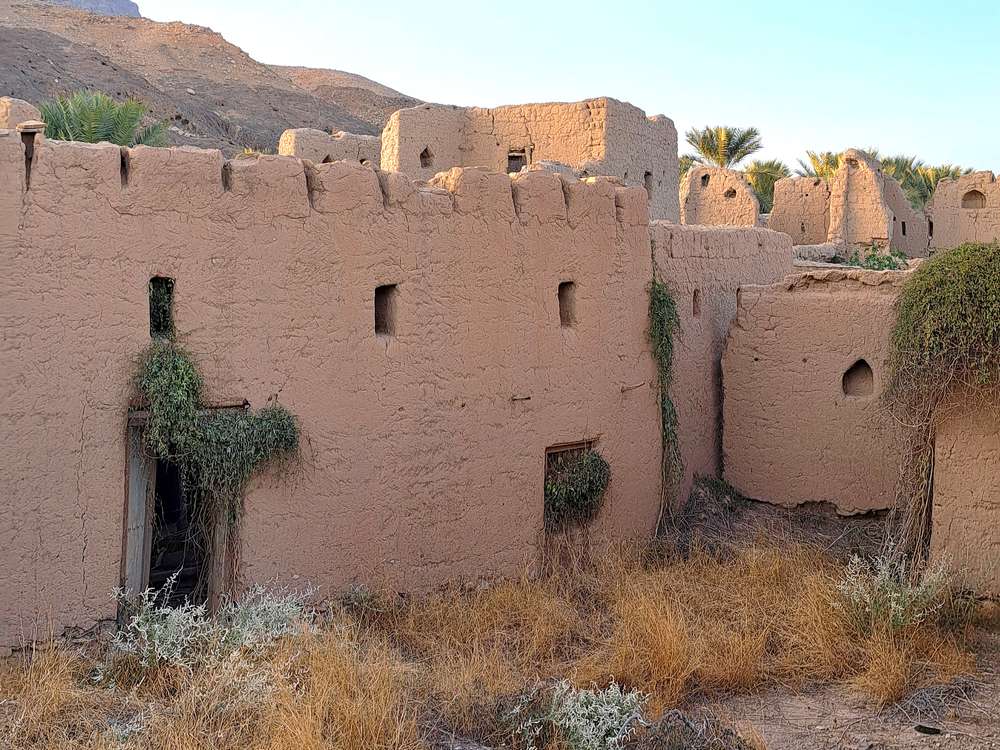
There is also a small fort or rather an observation tower a few steps from the old village. Find it by following this link:
📸 See more photos of Al Ghafat
Visit Jebel Akhdar
Jebel Akhdar, or Jabal Al Akhdar is a mountain in the Al Hajar range. This is a place not to be missed if you are a lover of hiking and outdoor activities.
Here is Jebel Akhdar can offer you:
● Green landscapes.
● Many hikes.
● Visit the many agricultural terraces.
● Many orchards (pomegranates, roses, apricots, walnuts, grapes, honey …).
● Countless wadis.
● Visit mountain villages, sometimes troglodytes.
● A climate much milder than the overwhelming heat of the plain. In addition, the weather can be cold in winter and exceptionally a little snowy (more common in Jebel Shams).
Mountain life is completely different from the plain. The atmosphere, the way of life, the climate and the landscapes… If you travel to Jebel Akhdar, you will see another side of the Sultanate of Oman.
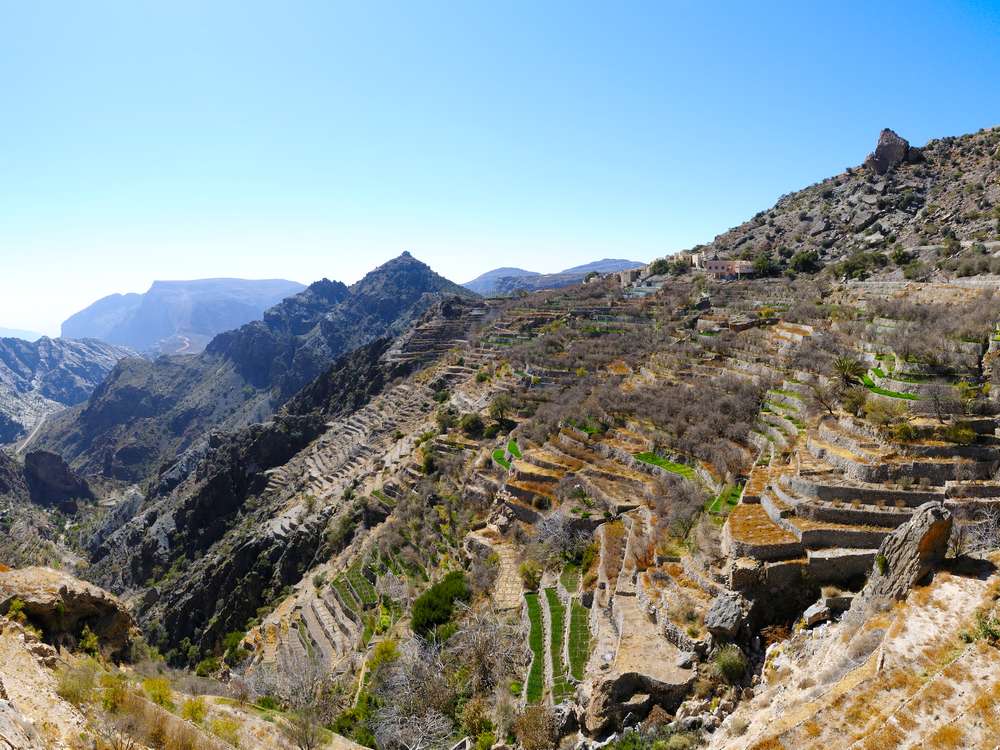
How to access it?
Jebel Akhdar is about 45 kilometers from Nizwa. This is a place that can be interesting to visit with a rental car. If you prefer to travel without, a good option could be a trekking/hiking trip with a few stops. Many tourists do this and go wild camping in the mountains.
Organized tour
● From Birkat Al Mouz, near the entrance of the fort, several people can offer you a tour to visit all these things I mentioned. The road to the mountains is at this point. You can arrange directly with them regarding the duration of your adventure and the price.
● The other departure to the mountain villages in Jebel Akhdar is in Imti. I met someone there very well with whom I spent some time. I highly recommend it. Feel free to contact me to get his phone number and plan a tour with him.
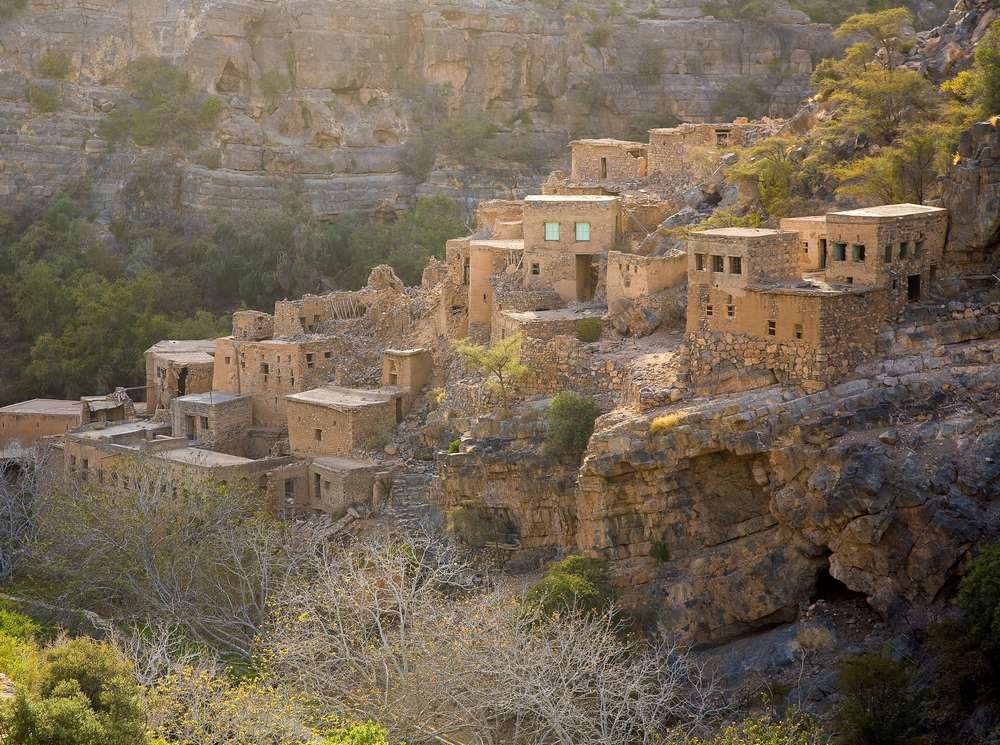
Visit Imti
Still searching on Google Maps for new villages to visit that are not found in guidebooks, I found Imti on my last day of travel to the Sultanate of Oman. Big surprise, this place is beautiful. In fact, historic sites are “divided” into 3 parts:
● One is in the heights of the city, on the rocky slopes and completely deserted. The vast village was built only with dry stones. Absolutely to see.
● The second part is an adobe village also deserted and similar to all the other sites listed in this article.
● The third part is the best and undoubtedly the reason why you should visit Imti. The village is mainly composed of dry stone and (partially) inhabited.
● The fourth part is similar to the previous one. Let’s take a closer look:
1. Harat Al Ain
Harat or Hart Al Ain is an ancient village that has been constantly maintained, or at least in part. It is composed of dry stone and adobe, with magnificent architecture. Its visit is very interesting since unlike the others, there is (a little) life inside. This gives us a brief glimpse of life in these Omani villages. I saw people washing in traditional showers above the falaj, a woman washing her clothes in the falaj wash house as well or just people in the houses.
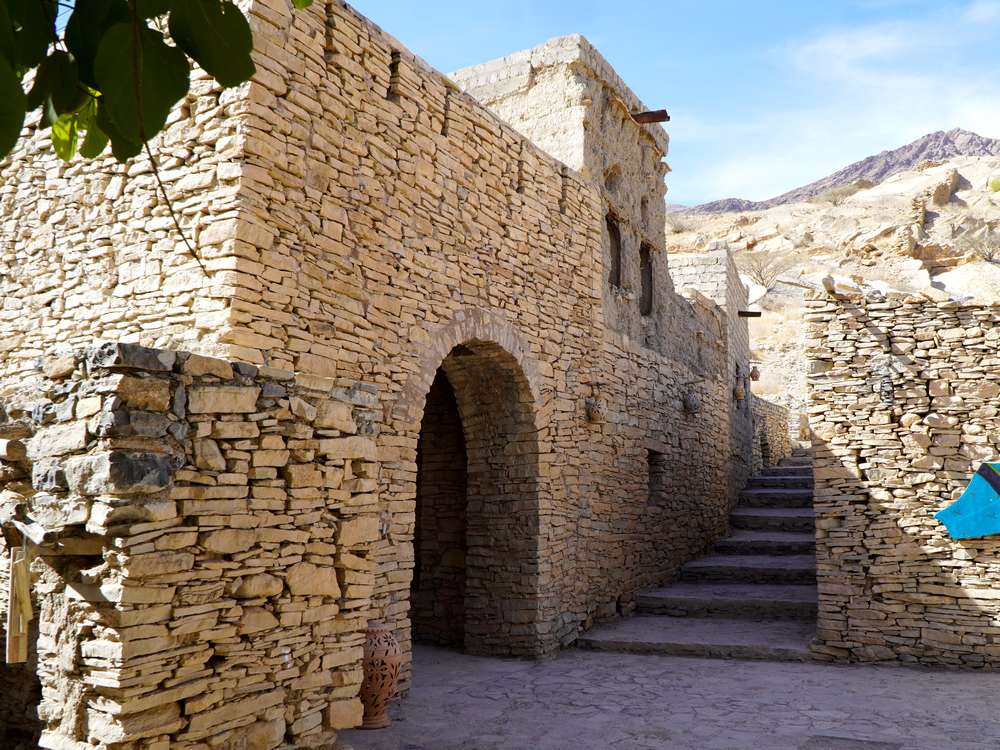
2. Harat Al Sawad
Harat Al Sawad is a few steps from Harat Al Ain and similar to this one but more deserted.
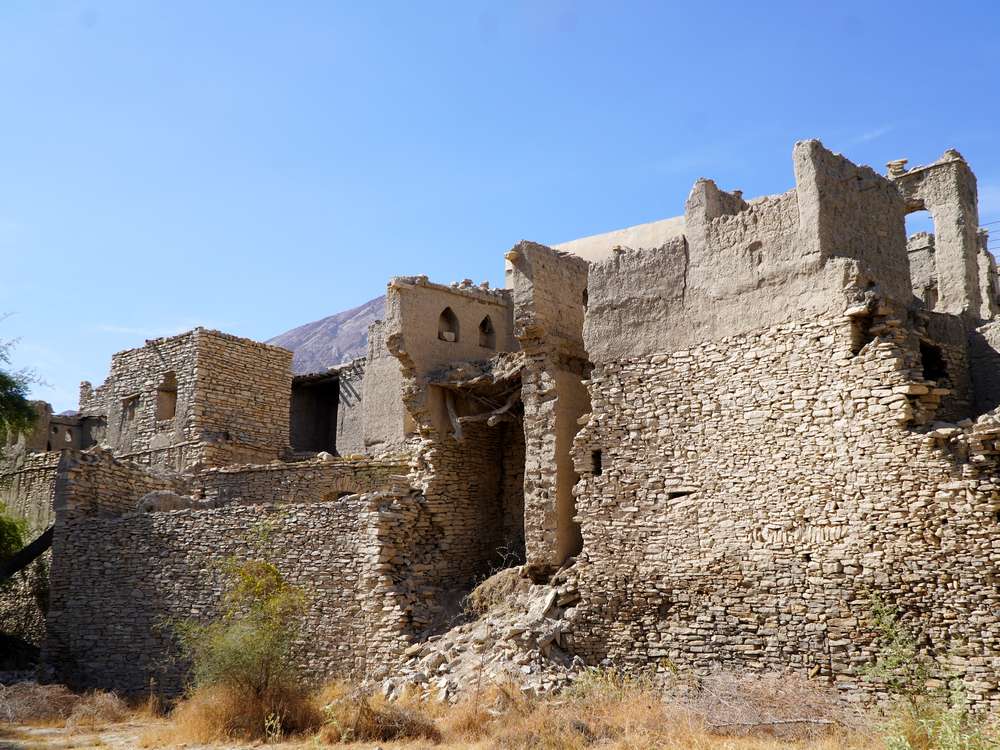
3. Harat Tawy Al Hamra
This village is very old and in a poor condition of conservation. It was built with dry stone and adobe.
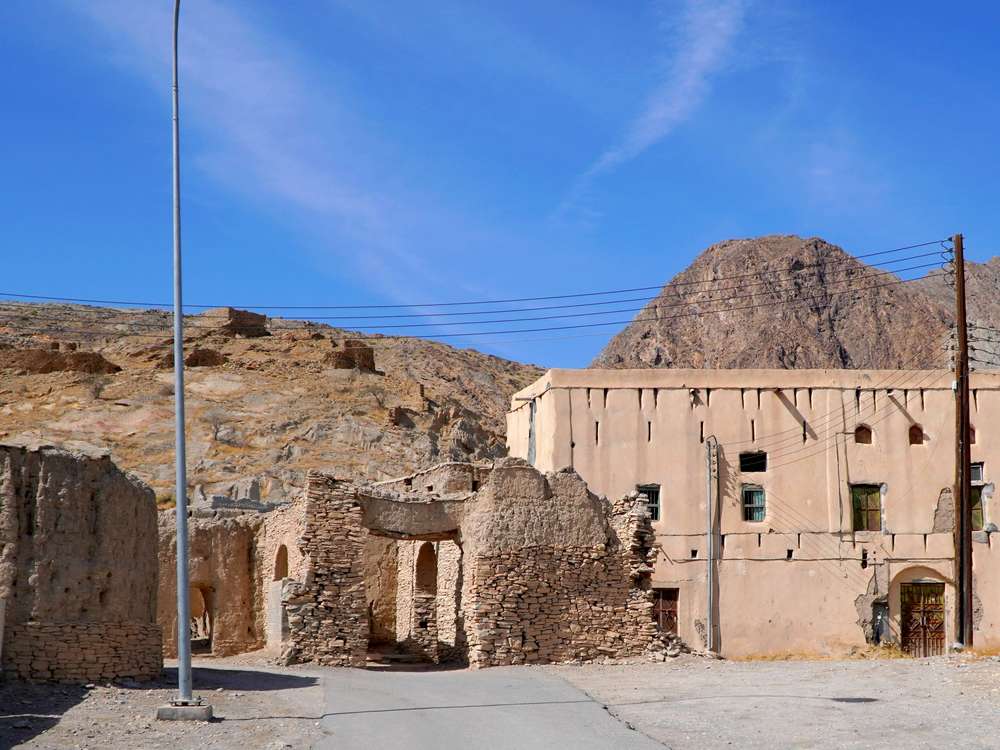
4. The village on the heights
Located above the previous place, this vast ruined village is composed only of dry stone and offers a breathtaking view of Imti.
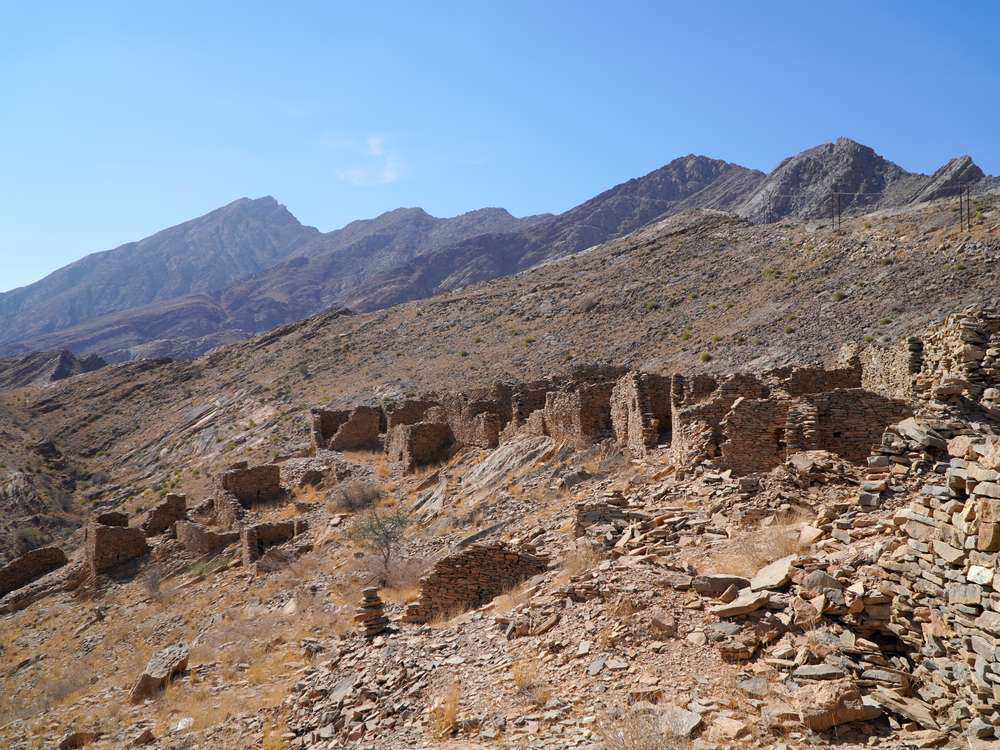
Visit Bidbid
Bidbid is the very first town in Ad Dakhiliyah governorate to arrive from Muscat. For stopping there, there is not much to visit except a pretty castle that is currently under restoration. So we can’t go inside for the moment.
In addition, Bidbid has the particularity of having extremely clear and bluish water in the wadi that borders the city (when it is not dry of course).
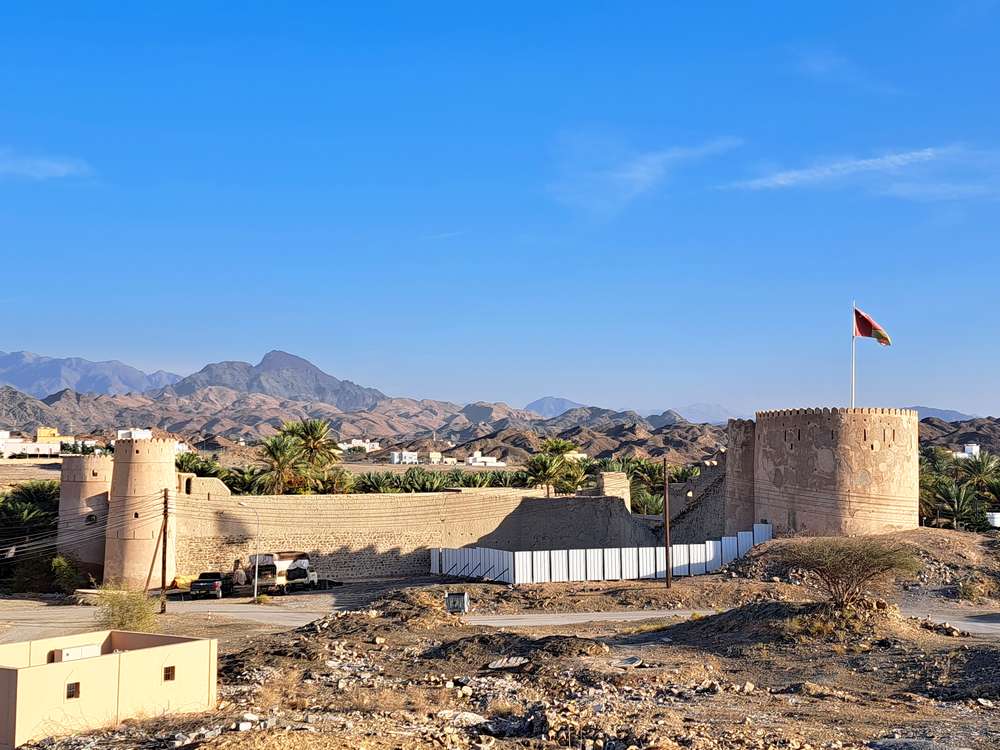
How to get to Nizwa?
From Muscat
🚕 By taxi
Go to the bus station in the locality of Rusayl (RTC bus station) north of Muscat. From here there are comfortable buses and shared taxis to go to Nizwa. A shared taxi costs OMR 4 per person. If you want to have a private driver all to yourself, the fare is 15 OMR.
The journey passes quickly since the roads are excellent and the expressways.
👍 Hitchhiking
I traveled to Oman only by hitchhiking except for a few taxis in Nizwa and Muscat (Muscat). It turns out that it works wonderfully. I talk about it better here.
How to get to Muscat from Nizwa?
To return to Muscat, you must go south of Nizwa, at the entrance of the city. The locality is called “Tanuf”. From here, there are private and collective taxis waiting for vehicles to fill up to reach the Omani capital.
When to visit Nizwa?
This weather also applies to Oman in general
● December to February : ≃ 12 to 30°C
● March to April & November : ≃ from 23 to 36°C
● May & October : ≃ from 32 to 42°C
● to September : ≃ 35 to 45°C
One-week itinerary
Oman, or formerly Magan, is a country with a very rich past that has benefited from a significant historical heritage. The Ad-Dakhiliyah region testifies to this, with its impressive number of archaeological sites, funerary complexes, fortified castles, ruins, remains of ancient cities and many other unquantifiable monuments.
Nizwa is only a crumb of what the region can offer you in terms of tourist activities.
Day 1
● Departure from Muscat
● Visit of Imti in the morning
1 hour drive
View on map
● Izki tour in the afternoon
20 min drive
View on map
● Overnight in Izki
Day 2
● Departure from Izki
● Visit Zukait Tombs in the morning
15 min drive
View on map
● Visit of Manah in the morning
30 min drive
View on map
● Visit of Nizwa in the afternoon
30 min drive
View on map
● Overnight in Nizwa
Day 3
● All-day tour of Nizwa
Ideally, match the stop with a Friday to visit the weekly market.
Day 4
● Departure from Nizwa
● Optional : stop at the ruins of Tanuf
20 min drive
View on map
● Visit the rock carvings near Al Hamra in the morning
25 min drive
View on map
● Visit of the historic village in the morning
15 min drive
View on map
● Visit Misfat Al Abriyyin in the afternoon
15 min drive
View on map
● Overnight in Misfat Al Abriyyin
Day 5
● Departure from Misfat Al Abriyyin
● Visit Bahla in the morning
40 min drive
View on map
● Visit Jabreen Castle in the morning
15 min drive
View on map
● Optional : stop at Al Ghafat
20 min drive
View on map
● Visit of the necropolis of Bat in the afternoon
1h15 drive
View on map
● Return and overnight in Bahla
1h15 drive
View on map
Day 6
● Departure from Bahla
● Visit Birkat Al Mouz in the morning
45 min drive
View on map
● Excursion to Jebel Akhdar from Birkat
30 min drive
View on map
● Overnight in Jebel Akhdar around Saiq
30 min drive
View on map
Day 7
● Relaxation and day activities in Saiq, Jebel Akhdar
● Return to Muscat
2 hours drive

Chapka insures your
trip in Oman
There are a thousand and one reasons to be confronted with a problem abroad. The reputation of Chapka in the travel industry is second to none. Get insured then travel hassle-free.
You will not pay any additional commission fee by using my affiliate link. On the other hand, you allow me get paid from my work and to keep Spirit-Travelers.com alive.


